I’m posting this a day late because I was not able to keep up with my journal as well while walking around Jerusalem.
I woke up at 6:30am to a sunny but chilly morning in Jerusalem. After a breakfast of scrambled eggs and cheeses (three types today), we boarded the bus at 8am for a short drive to the Mt of Olives. Keith Parker led us in a prayer as we left.
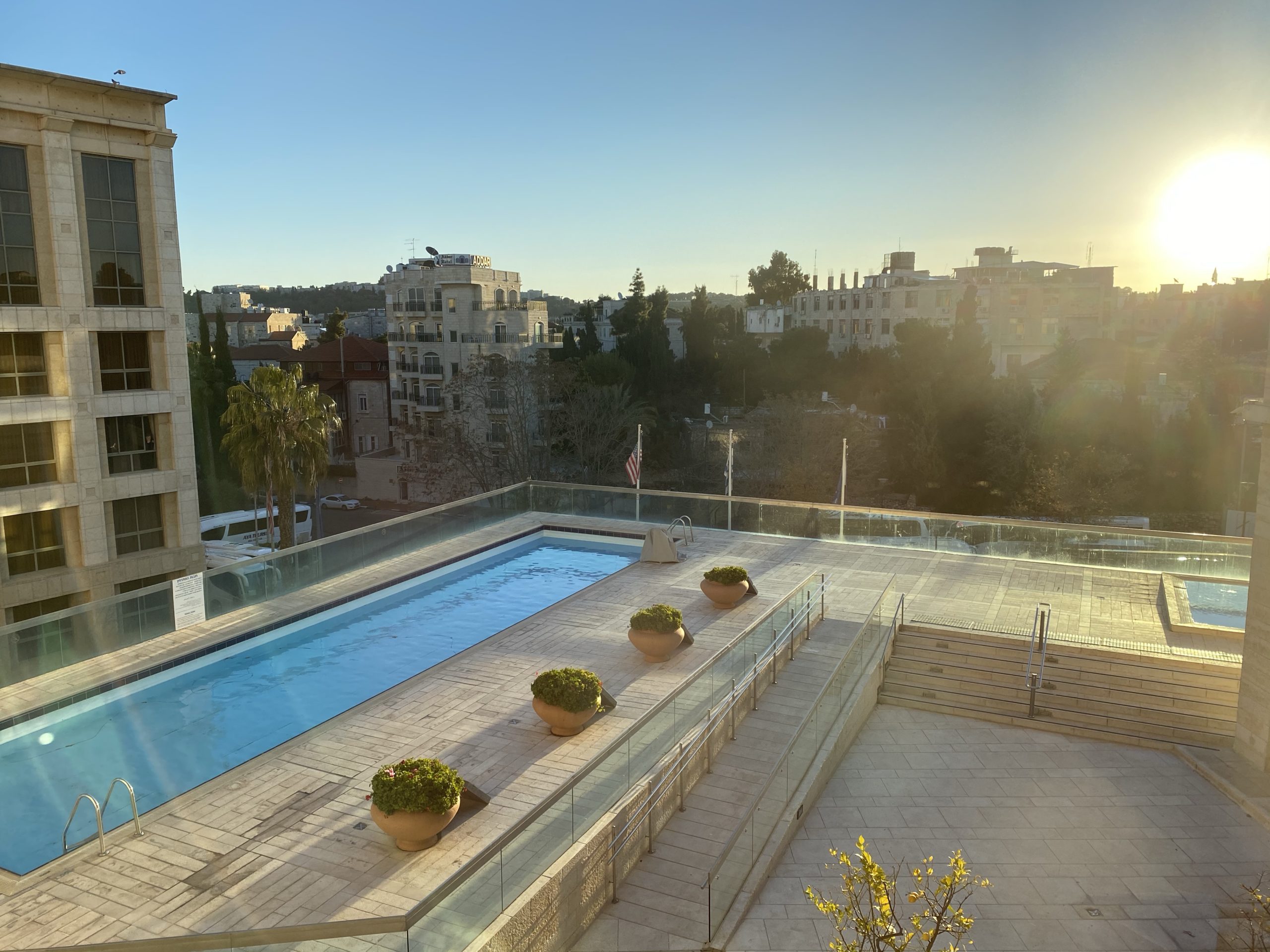
Today we focused on ministry of Jesus in and around the Old City of Jerusalem. This was a very different day than the others for two primary reasons:
*We spent most of our time walking rather than riding in the bus.
*With a few exceptions (i.e. Mt. of Olives, Garden of Gethsemane, the Garden Tomb, etc.) almost nothing that we saw today was actually from the time of Jesus or anything in the Biblical account.
On this second point, I would describe most of today as “touristy” as we visited a lot of “traditional” sites for events where we actually have no idea what happened. So, it was a good day, but just very different.
While driving through Jerusalem, Murad explained to us that from the time of the British control of Israel there has been a mandate that all buildings be built of limestone. This creates very beautiful buildings, but costs $150 per square meter.
Mount of Olives
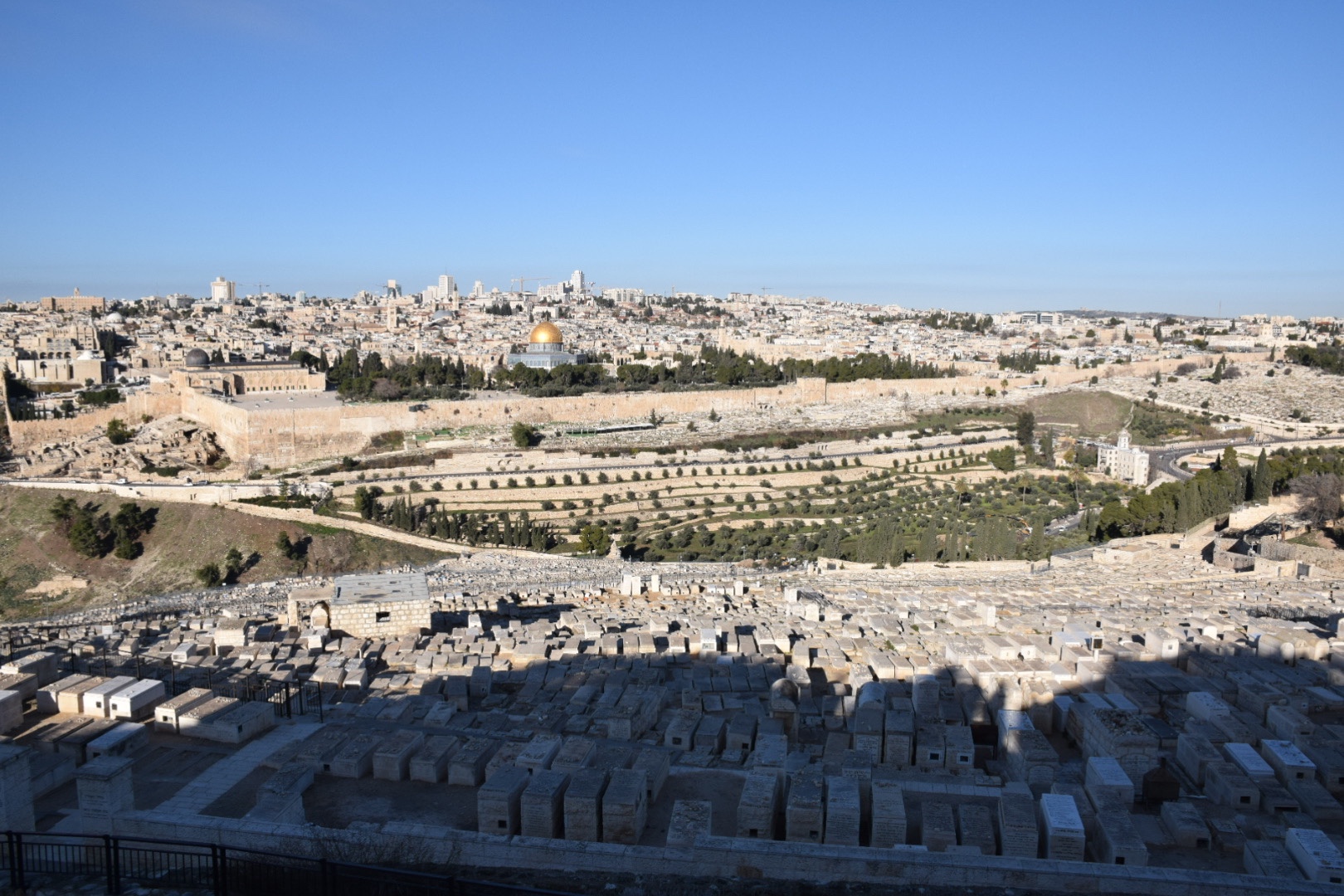
Our first stop was at the Mt. of Olives on the east side of Jerusalem. The Mt. of Olives is a ridge running along the east side of Jerusalem, separated from the city walls by a ravine and the Kidron Valley. Today the Mount of Olives is dotted with many churches, including the Church of All Nations, the Church of Mary Magdalene, the Church of the Assumption, the Church of Dominus Flevit, the Church of St. Lazarus, and the Chapel of the Ascension. It is also covered in Jewish tombs. In the time of Jesus, this would have simply been a mountain filled with olive trees. The Mount of Olives was the site of many events in the Bible:
*When David’s son Absalom wrested control of Jerusalem, David and his loyal followers fled the city via an eastern route and David went up the Mt of Olives weeping (2 Samuel 15:30).
*King Solomon used the Mount of Olives for idol worship (1 Kings 11:7).
*In one of Ezekiel’s visions, the prophet sees the glory of the Lord depart from Jerusalem and come to rest above the Mt of Olives (Ezekiel 11:23).
*Jesus made many visits to the Mount of Olives (Luke 21:37). In fact, it was His “custom” to go there when in the vicinity of Jerusalem (Luke 22:39). Every time Jesus visited Lazarus and Mary and Martha, He was on the Mount of Olives, for their village of Bethany was situated on the eastern slope.
*Jesus visits the Mount of Olives three times in the last week of life, and each time something of significance happened.
(1) The first visit during His final week was during the triumphal entry – The donkey Jesus rode that day was found in the area of Bethany and Bethpage, on the east side of the Mount of Olives (Matthew 21:1–11, Mark 11:1–11, Luke 19:28–44). Then, “when he came near the place where the road goes down the Mount of Olives, the whole crowd of disciples began joyfully to praise God in loud voices for all the miracles they had seen” (Luke 19:3737). While still on the Mount of Olives, Jesus looked at the vista in front of Him, wept over the city, and pronounced a judgment against it (Luke 19:41–44).
(2) Jesus’ second visit that week was to deliver what has come to be known as the Olivet Discourse, recorded in Matt 24:1 —25:46. Parallel passages are found in Mark 13:1–37 and Luke 21:5–36. The content of the Olivet Discourse is Jesus’ response to His disciples’ question “When will these things be, and what will be the sign of your coming and of the close of the age?”
(3) Jesus’ third visit that week was on the night He was betrayed. That evening began with the Last Supper in Jerusalem and ended in the Garden of Gethsemane on the Mount of Olives. He took His disciples to the Garden of Gethsemane (literally, “Garden of the Olive-press”) located on the western slope of the Mount of Olives. There Jesus prayed in agony as He contemplated the day to come. After Jesus prayed, Judas Iscariot arrived with a multitude to betray and arrest Jesus (Matt 26:30–56; Mark 14:26–50; Luke 22:39-53).
*After His resurrection, Jesus once again stood on the Mount of Olives where He ascended into Heaven (Luke 24:50–52; Acts 1:11-12). Acts 1:12 specifies that “the vicinity of Bethany” was indeed the Mount of Olives.
*According to the prophet Zechariah, Jesus will return not only in the same way, but to the same place. In a prophecy related to the end times, Zechariah declares, “On that day his feet will stand on the Mount of Olives, east of Jerusalem, and the Mount of Olives will be split in two from east to west, forming a great valley, with half of the mountain moving north and half moving south” (Zechariah 14:4).
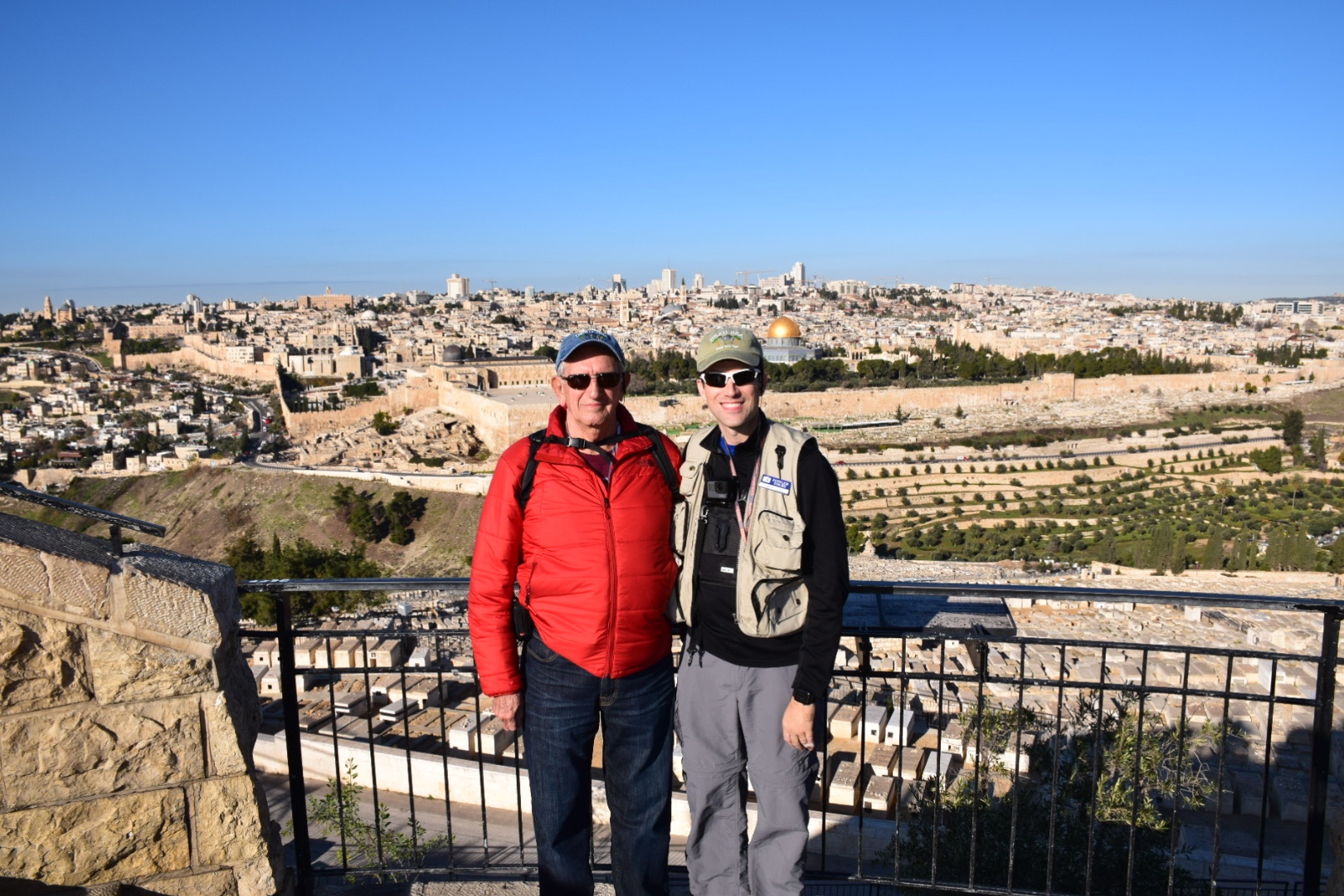
Pulling into the Mt of Olives, we caught our first incredible glimpse of the city of Jerusalem below out of the right-hand side of the bus. The view was even more spectacular outside the bus, and it quickly brought to mind Jesus seeing and weeping over the city from the Mt. of Olives during his Triumphal Entry as mentioned above. At the site, we first took a quick group picture, and then Murad gave us an overview of the city and area below. Some of the highlights included:
*The Old City of Jerusalem – Murad explained that the Old City covers one square kilometer and has a population of 50,000 people. The walls around the old city were built in 1536. The city wall has 8 gates, and one gate, the Golden Gate (or Gate of Mercy), has been sealed since medieval times. Murad explained that this city is not the city that Jesus was in, but one is built on top of the Jerusalem of Jesus’ day. He said that the whole city is a Tel with many strata.
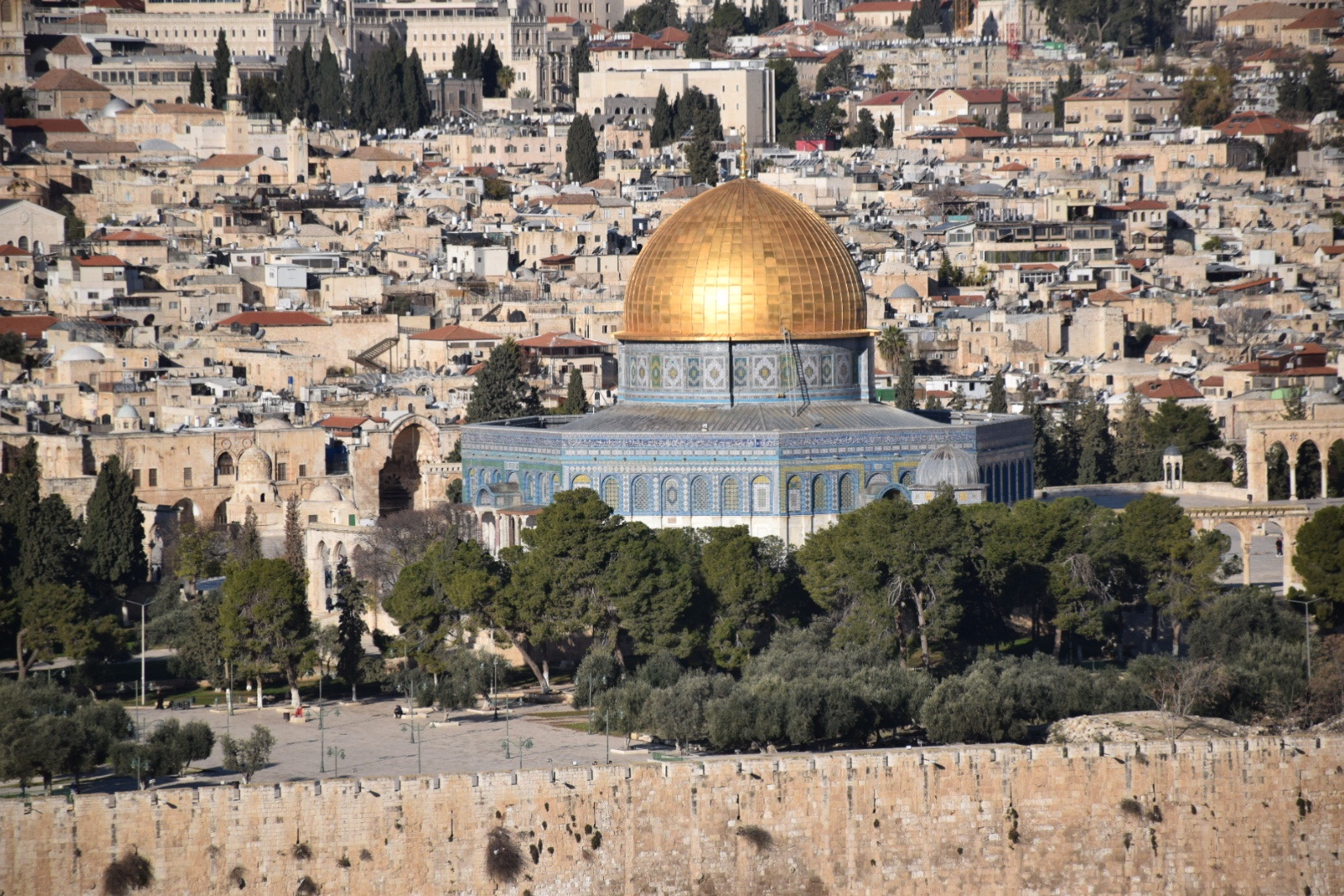
*The Dome of the Rock – An Islamic shrine located on the Temple Mount in the Old City of Jerusalem. It was initially completed in 691–92 AD. It covers the “Foundation Stone” that Muslims believe to be the site where Abraham attempted to sacrifice his son on Mt. Moriah. This is the most striking place in the skyline of Jerusalem.
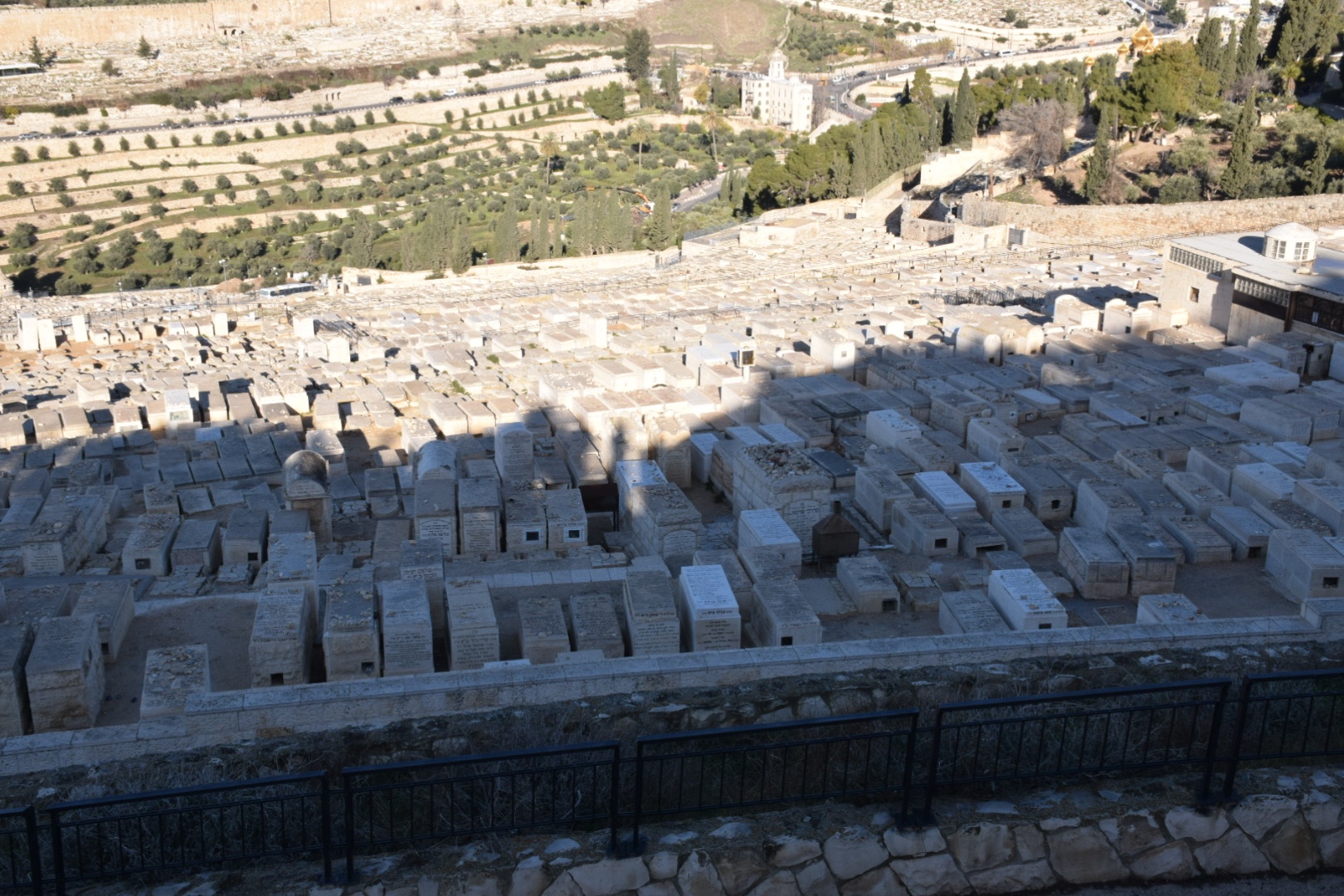
*Jewish Tombs on the western slope of the Mt. of Olives.
*The Kidron Valley (Brook) – A brook and valley on the eastern side of Jerusalem. This location is mentioned numerous times in scripture as a boundary (2 Sam 15:23, 1 Kgs 2:37, etc.).
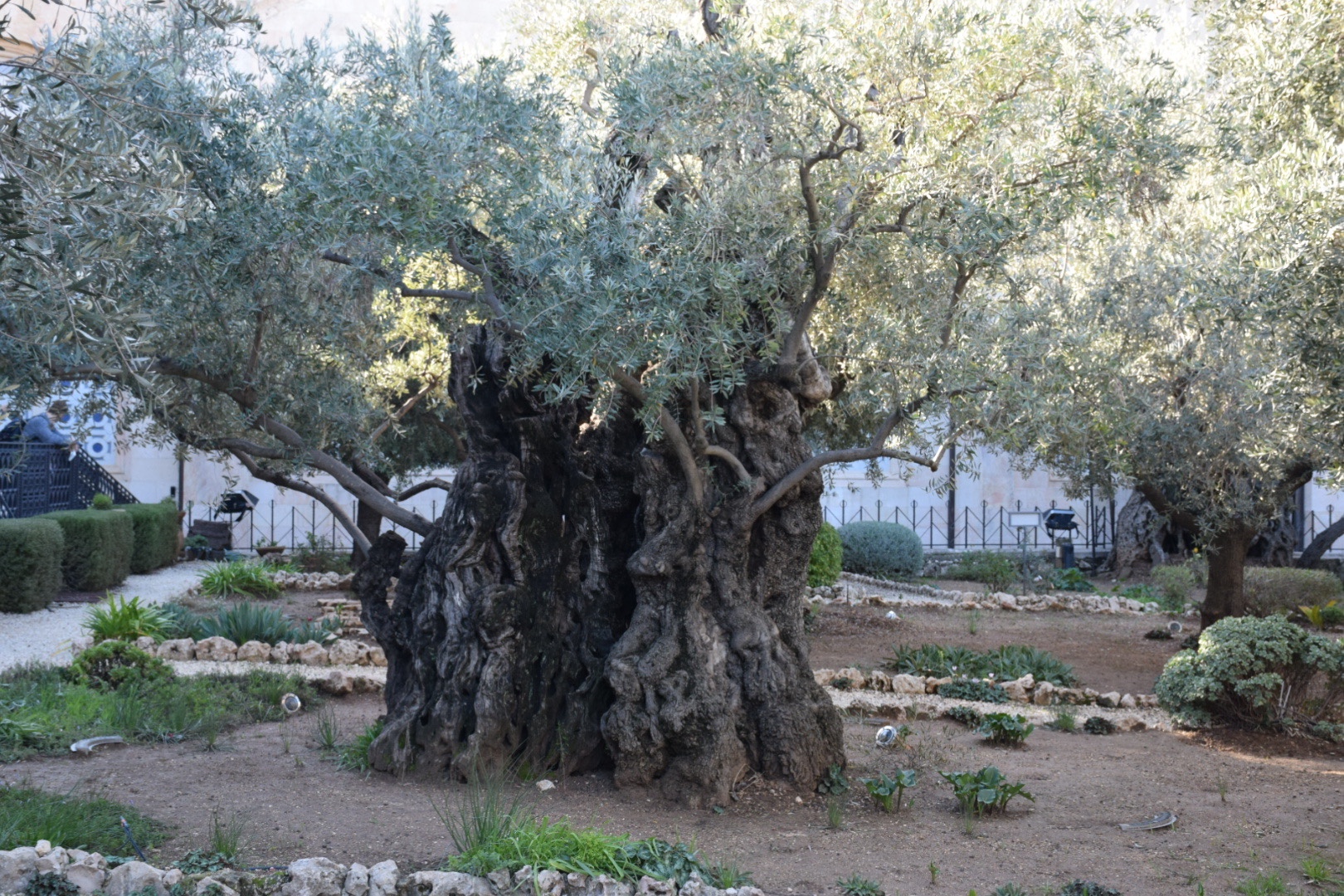
We took a short bus ride to the western side of the Mount of Olives, to the traditional spot of the Garden of Gethsemane (While we know that the garden was on the western side, we don’t know the exact spot). This particular location contains 8 ancient olive trees that are dated to be approximately 900 years old (much past the time of Jesus).
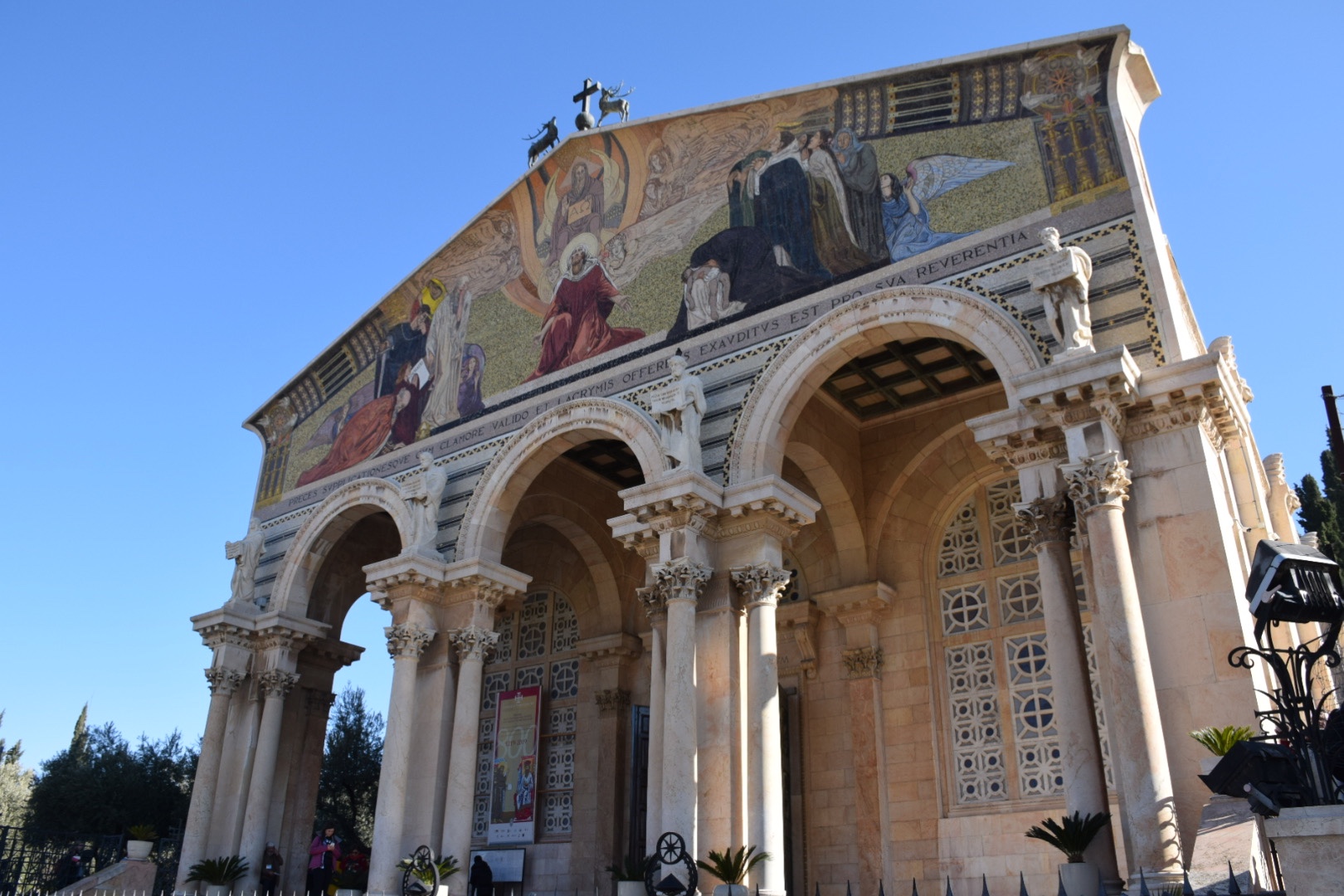
They are located next to the Church of All Nations or the Church of Agony, named after Jesus’ prayer of agony in the garden. The front facade of this church building is covered in beautiful mosaics, and the inside contains mosaics depicting…
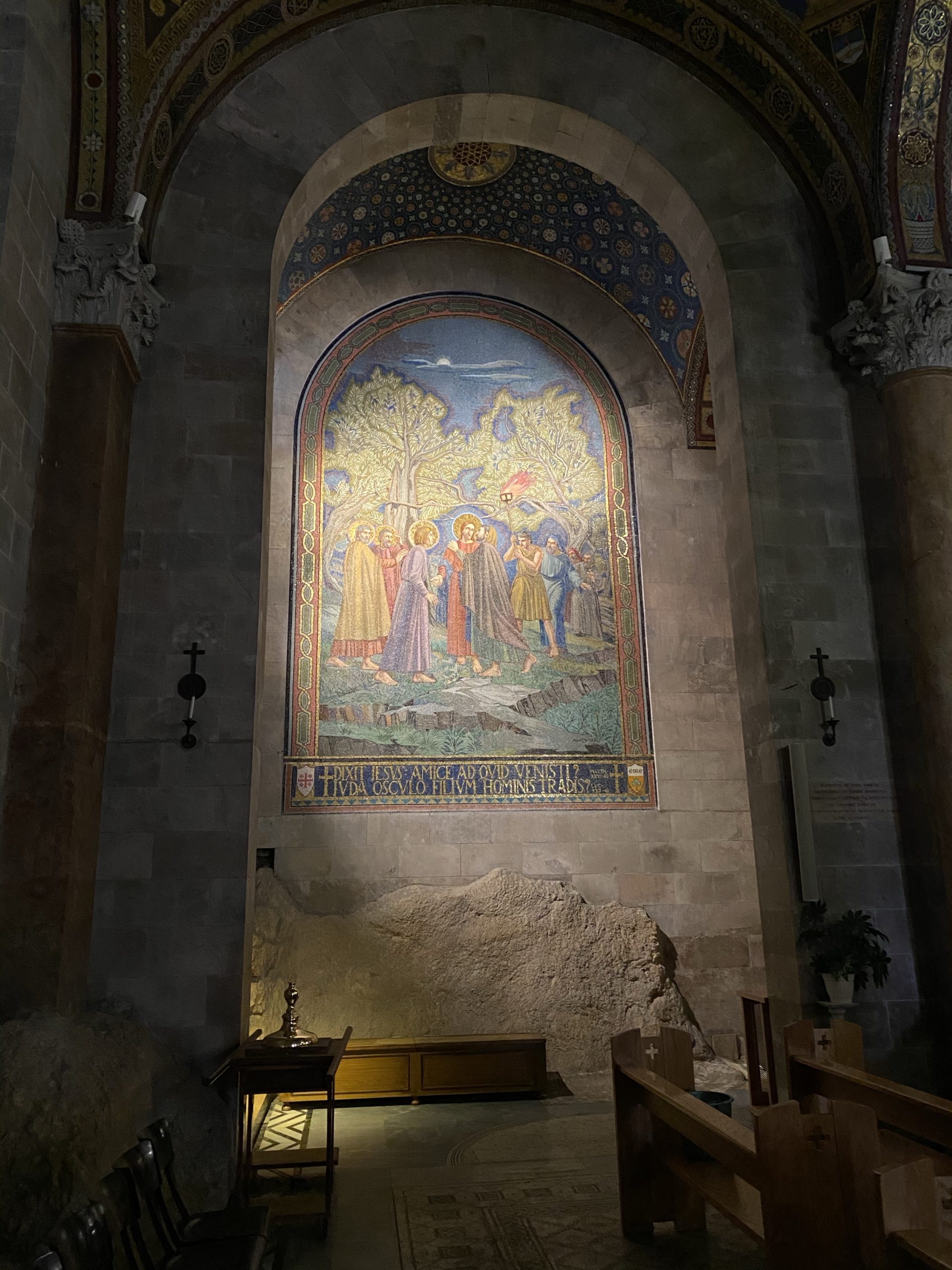
Judas’ betrayal kiss (Matt 26:47-50; Mark 14:43-46; Luke 22:47-48),
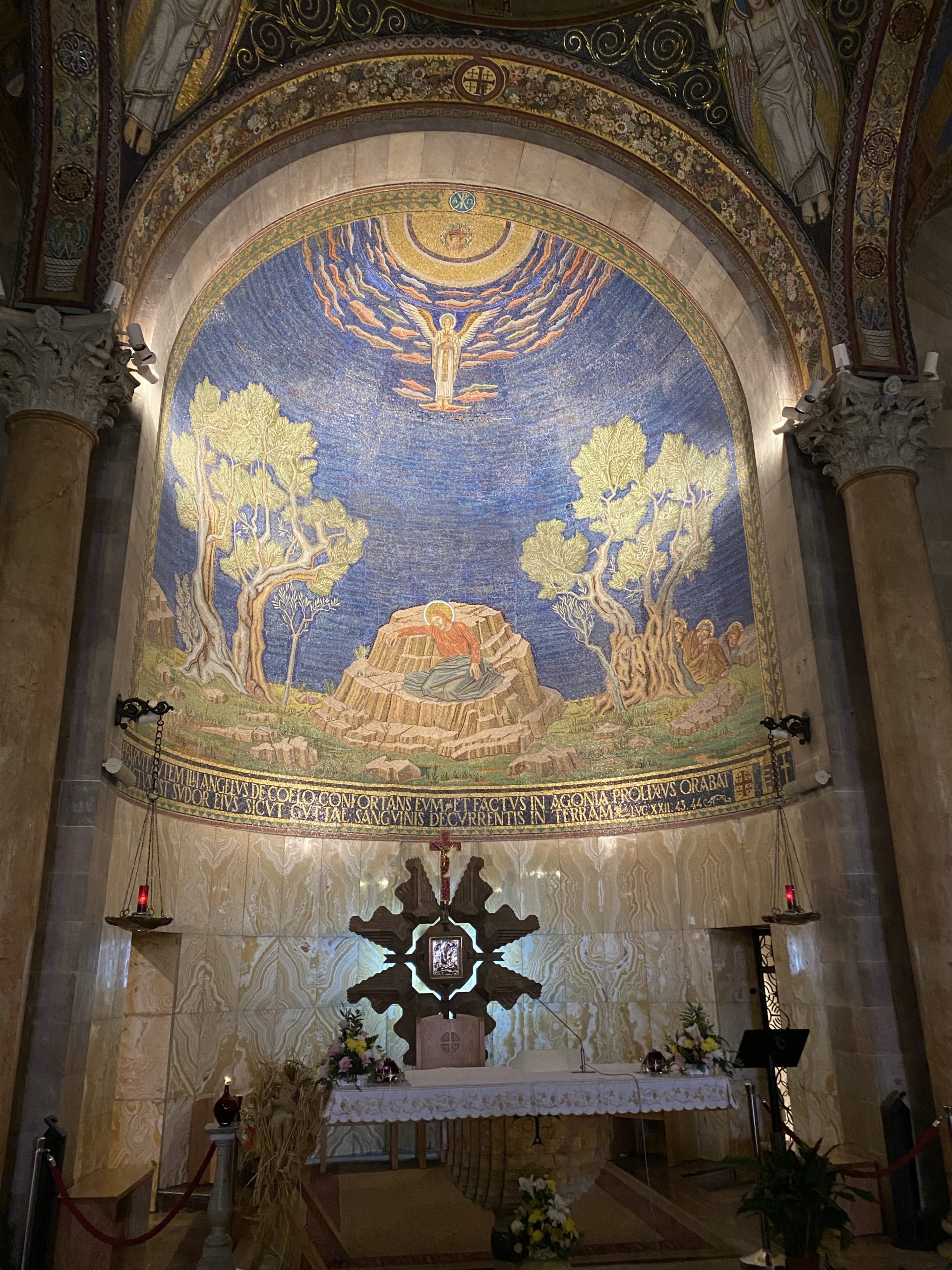
Jesus’ prayer of agony (Luke 22:44), and
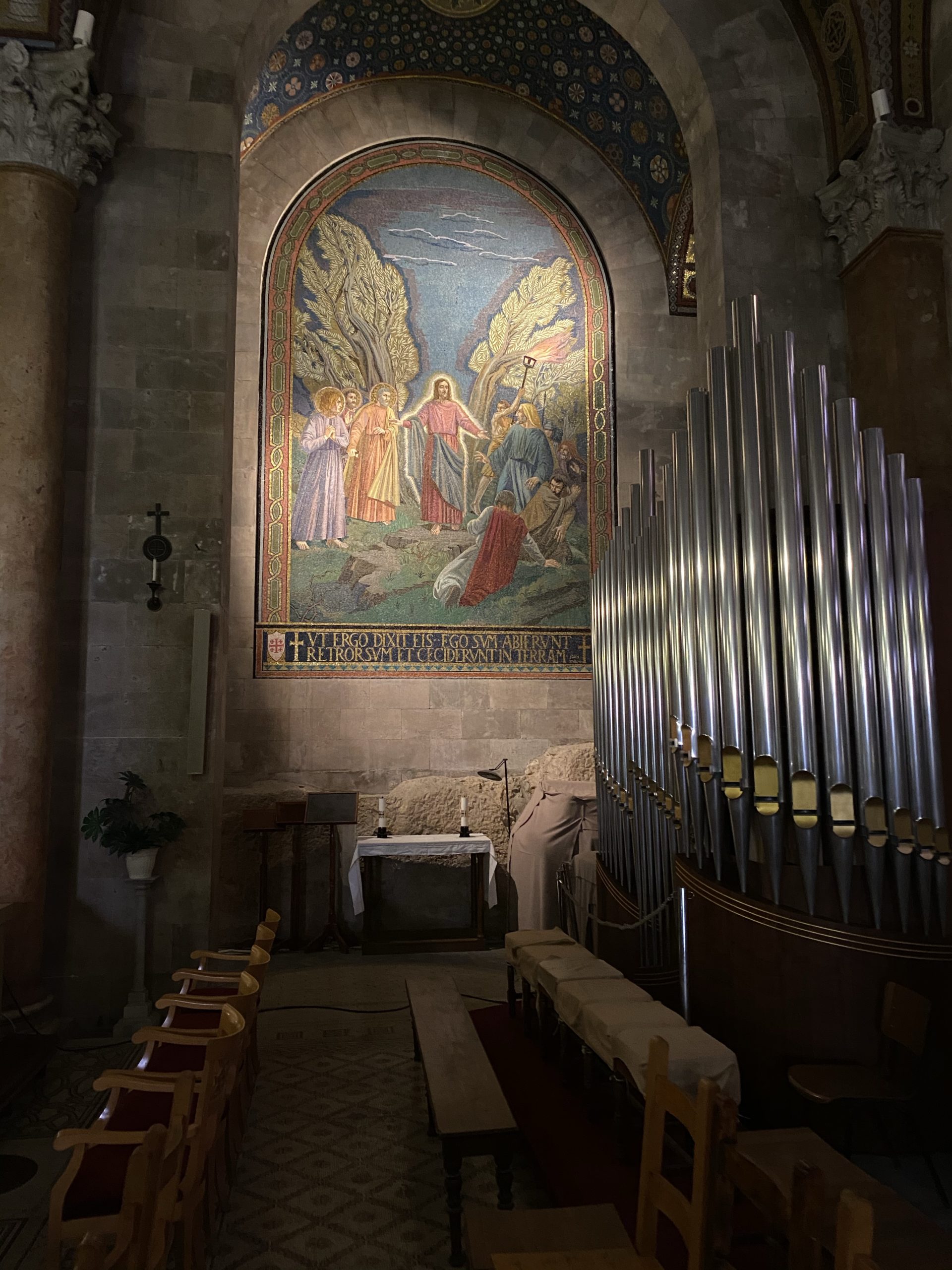
Jesus healing the ear of Malchus after Peter cut it off (Luke 22:51; John 18:10).

Looking back on our day, being on the Mt. of Olives was definitely the highlight due to the incredible view of the city and, more importantly, knowing what significant biblical events happened in this place.
Old City of Jerusalem
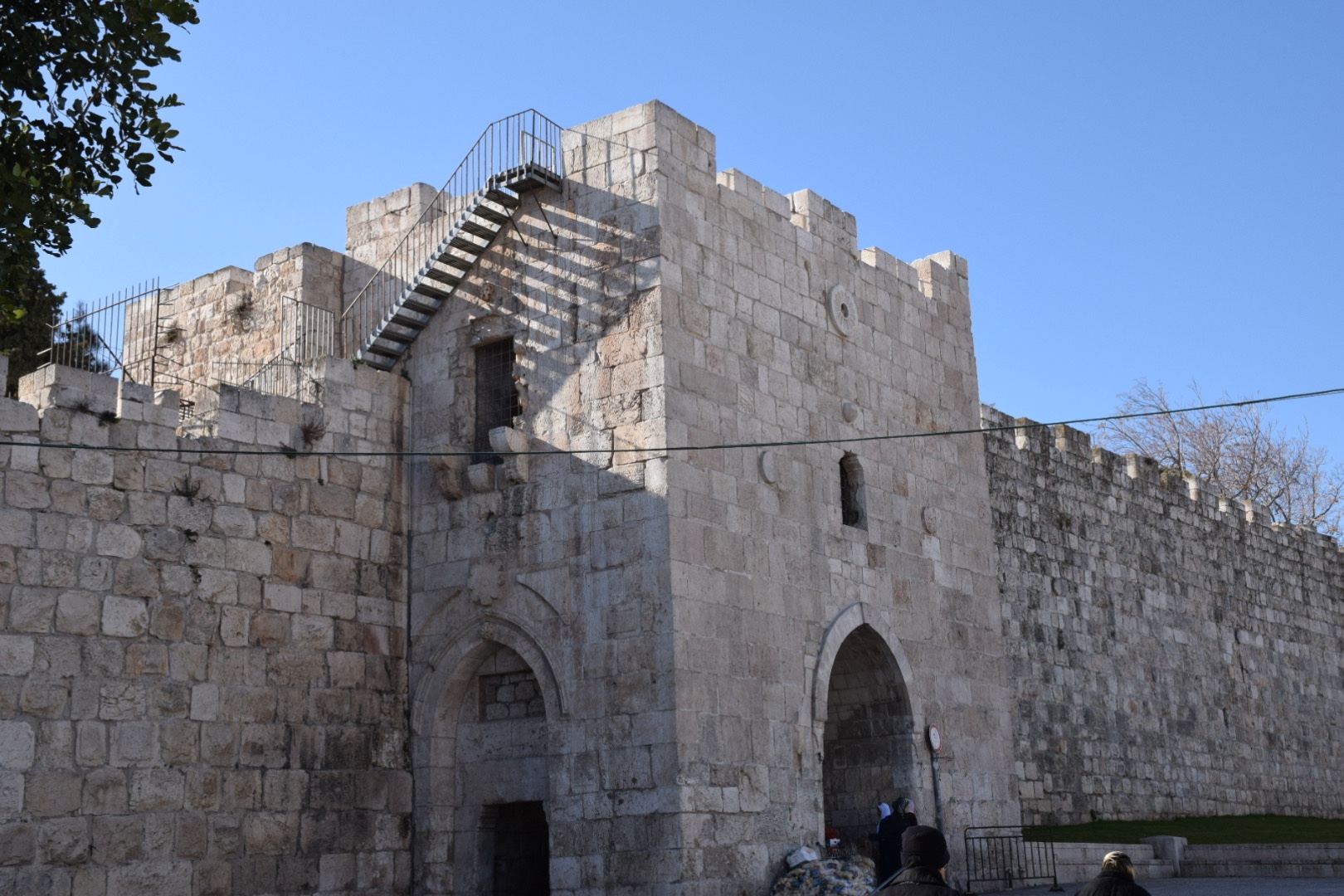
After another short bus ride, we exited just outside of the Old City of Jerusalem at Herod’s Gate (another one of eight gates).
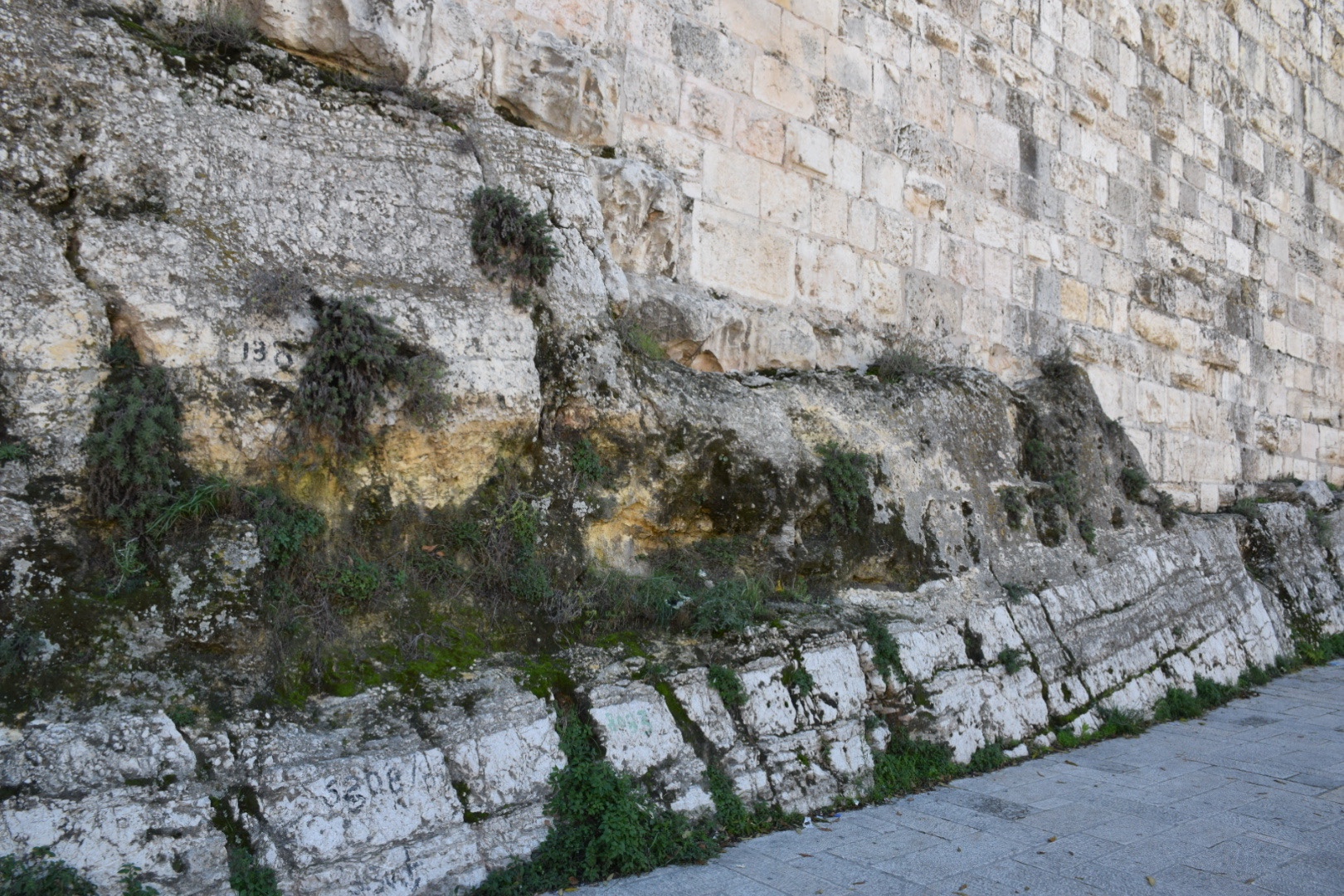
Murad pointed out that the walls of old city were built on natural rock and said that this reminded him of the parable of the wise man and foolish man in Matthew 7:24-27. He also explained that in the time of Jesus, the walls of the city were further down the hill toward Kidron than they are today.
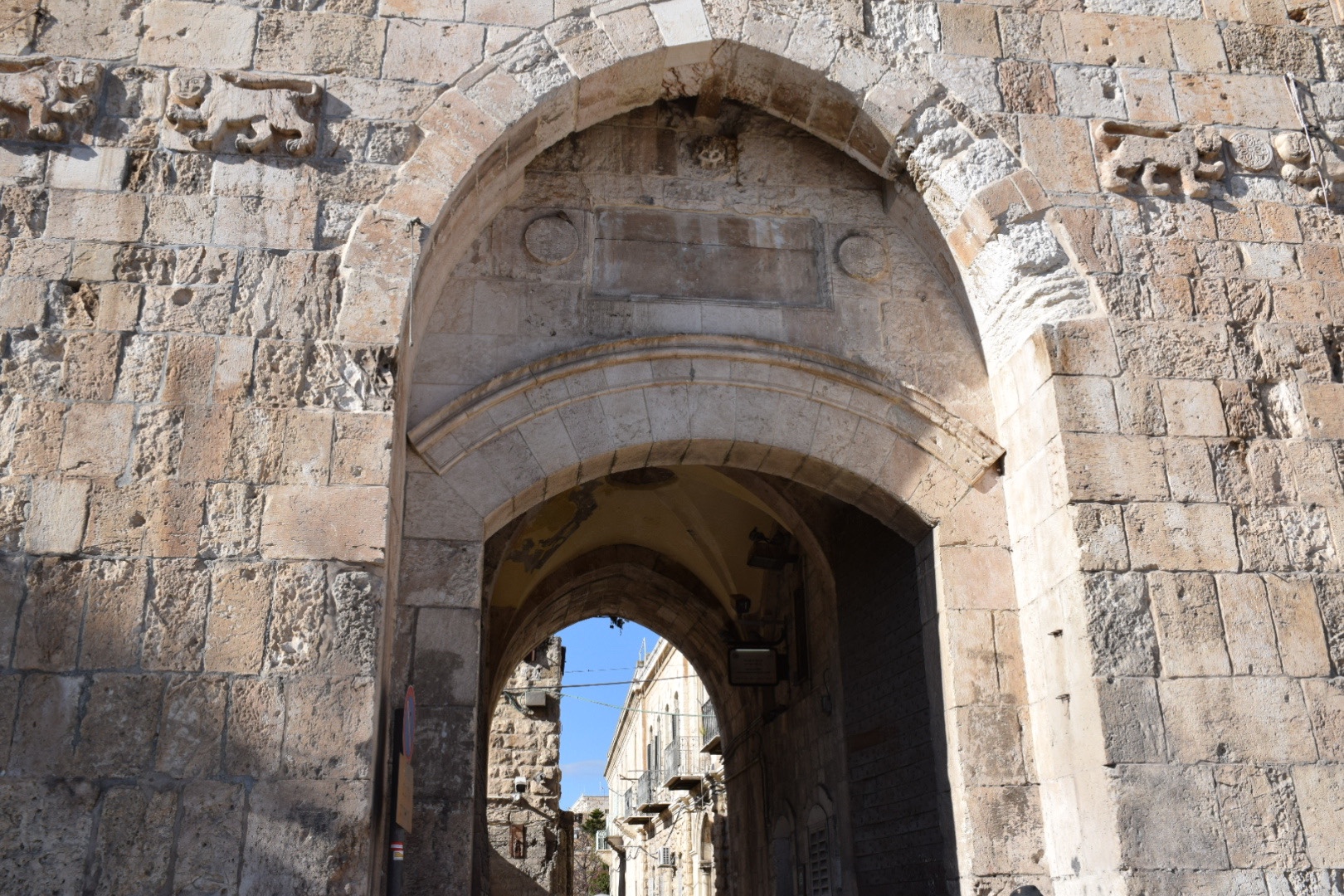
From there, we walked around to the eastern side of the city to the Lions Gate, also known as St. Steven’s Gate, because this is the traditional site of the stoning of Steven in Acts 7:58. We entered the old city through this gate and made our way to the Pool of Bethesda at the site of the Basilica of St. Anne’s.
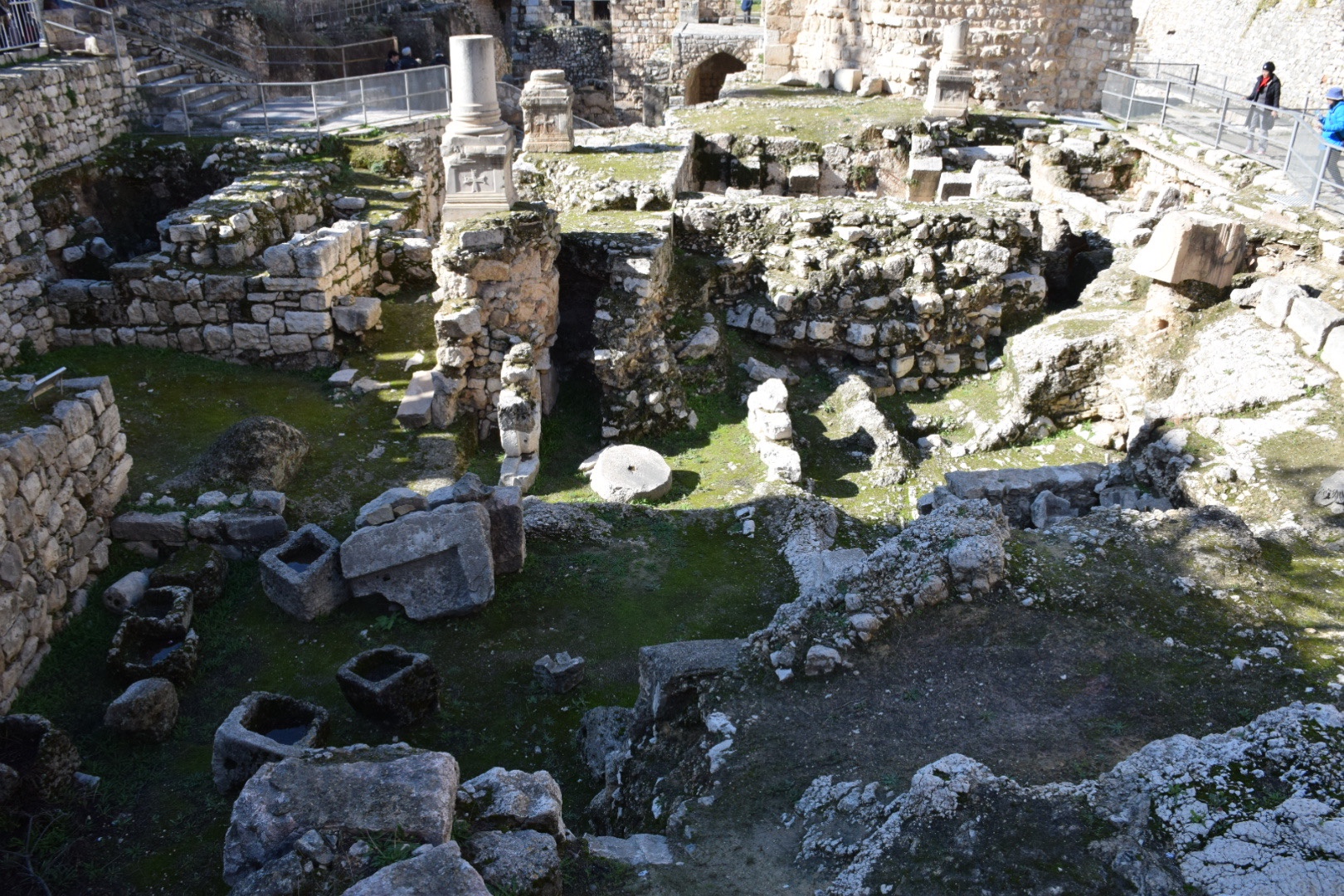
The Pool of Bethesda was a 5-porch-pool and was the place where Jesus healed the paralytic in John 5:2-17. Murad showed us the part of this pool that has been excavated, and dated to the time of Jesus, but said that much of it is likely under the Basilica.
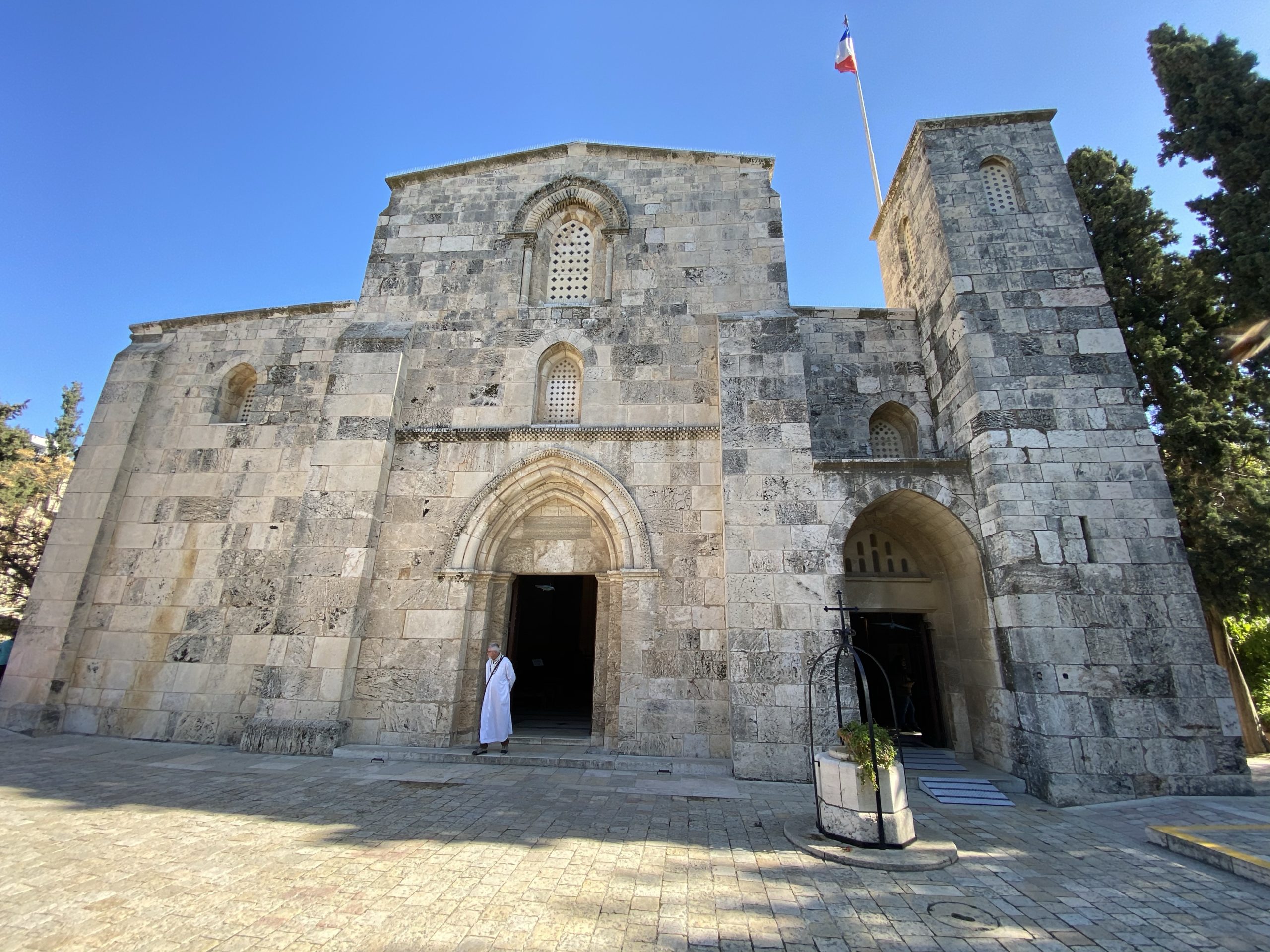
The Basilica of St Anne’s is an 800-year-old Coptic church this is owned by the French Government. It is built on top of a cave that is the traditional birthplace of Mary the mother of Jesus.

St Anne’s is known for its incredible acoustics, and as we went inside our group sang a number of hymns. This was an awesome experience and sounded amazing.
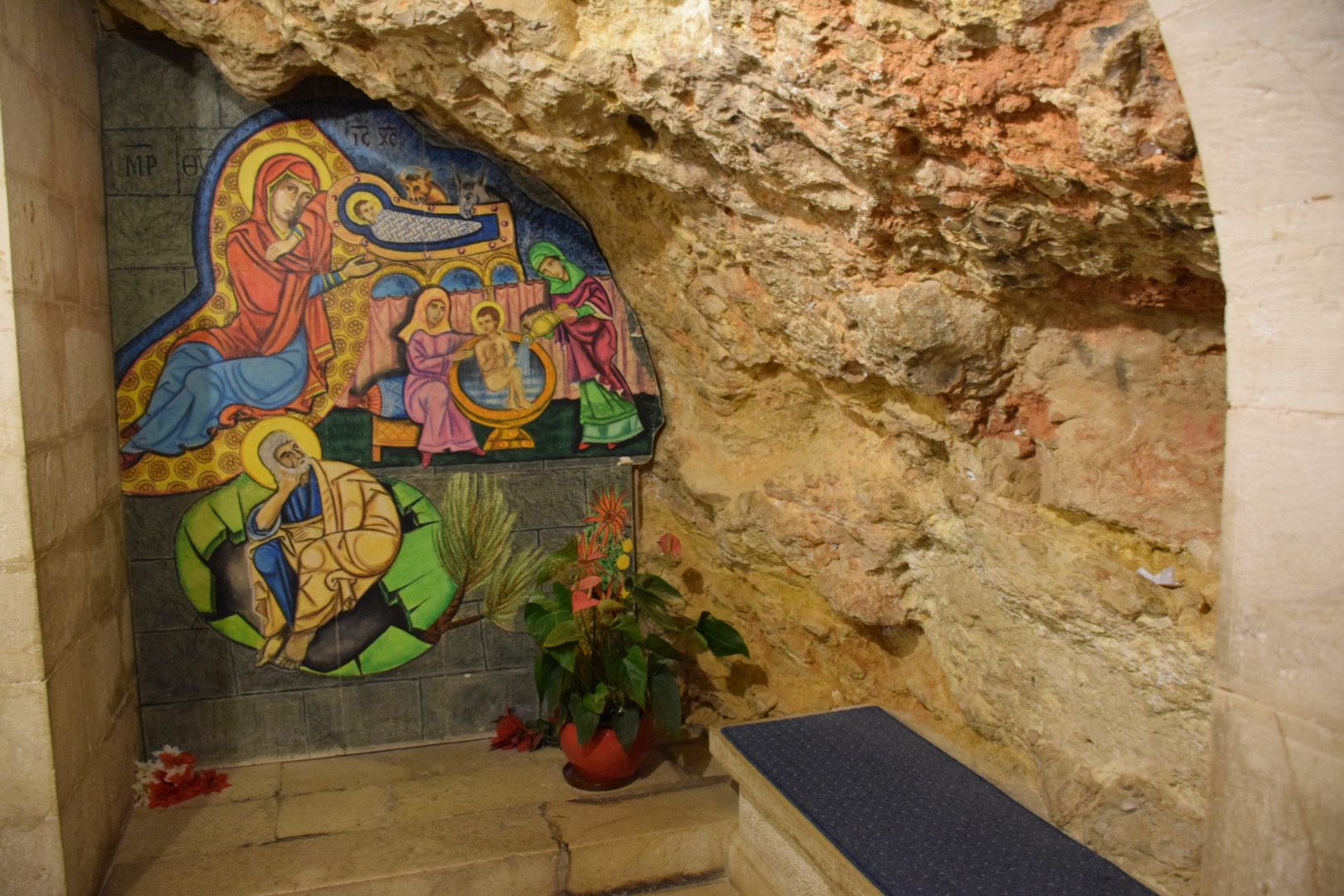
After finishing the hymns, I quickly went downstairs to get a glimpse of the cave before heading back outside. On a side note, one thing I noticed walking around Old Jerusalem is how hilly it was, with rolling hills throughout the city.
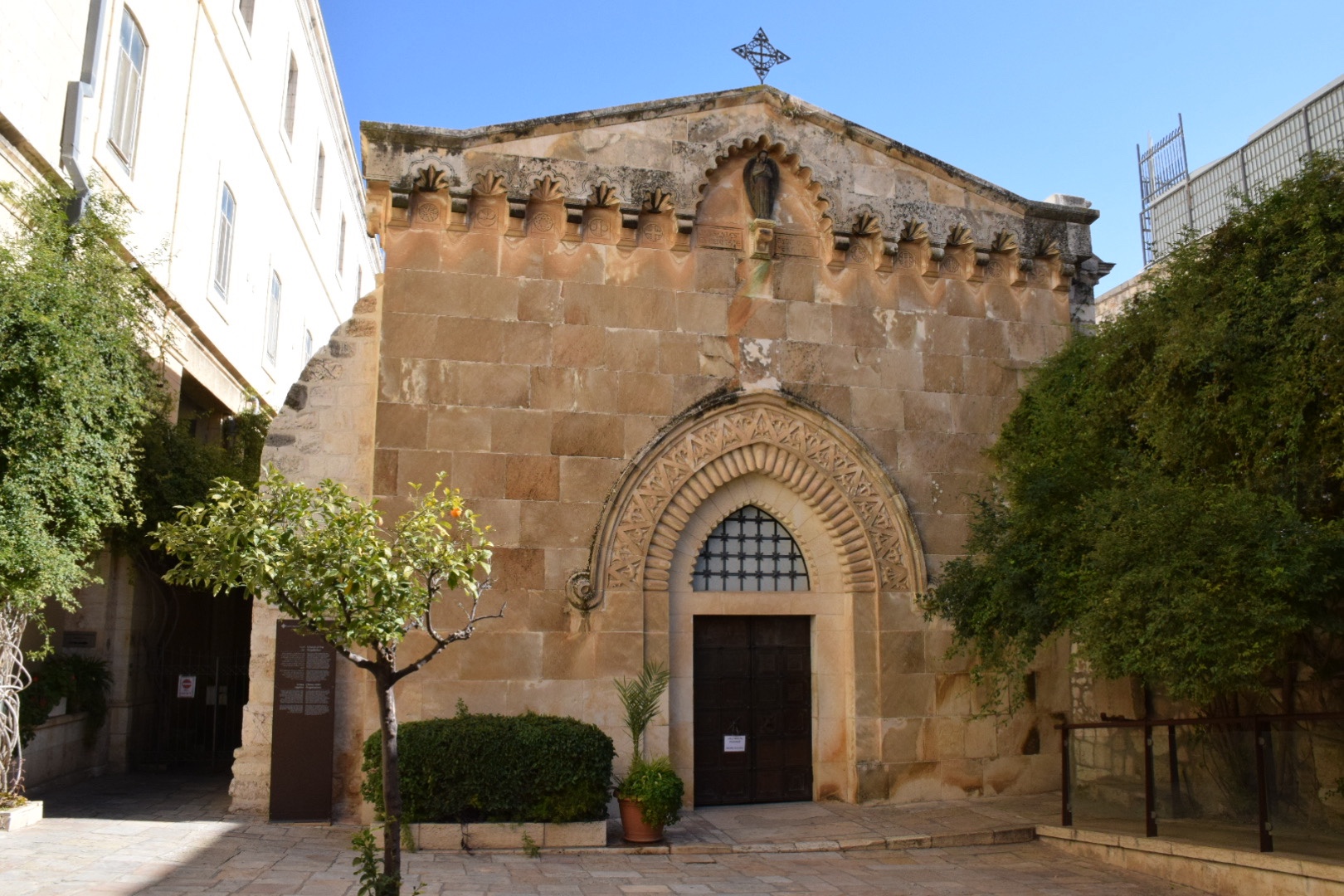
Our next stop was at the Church of Flagellation…
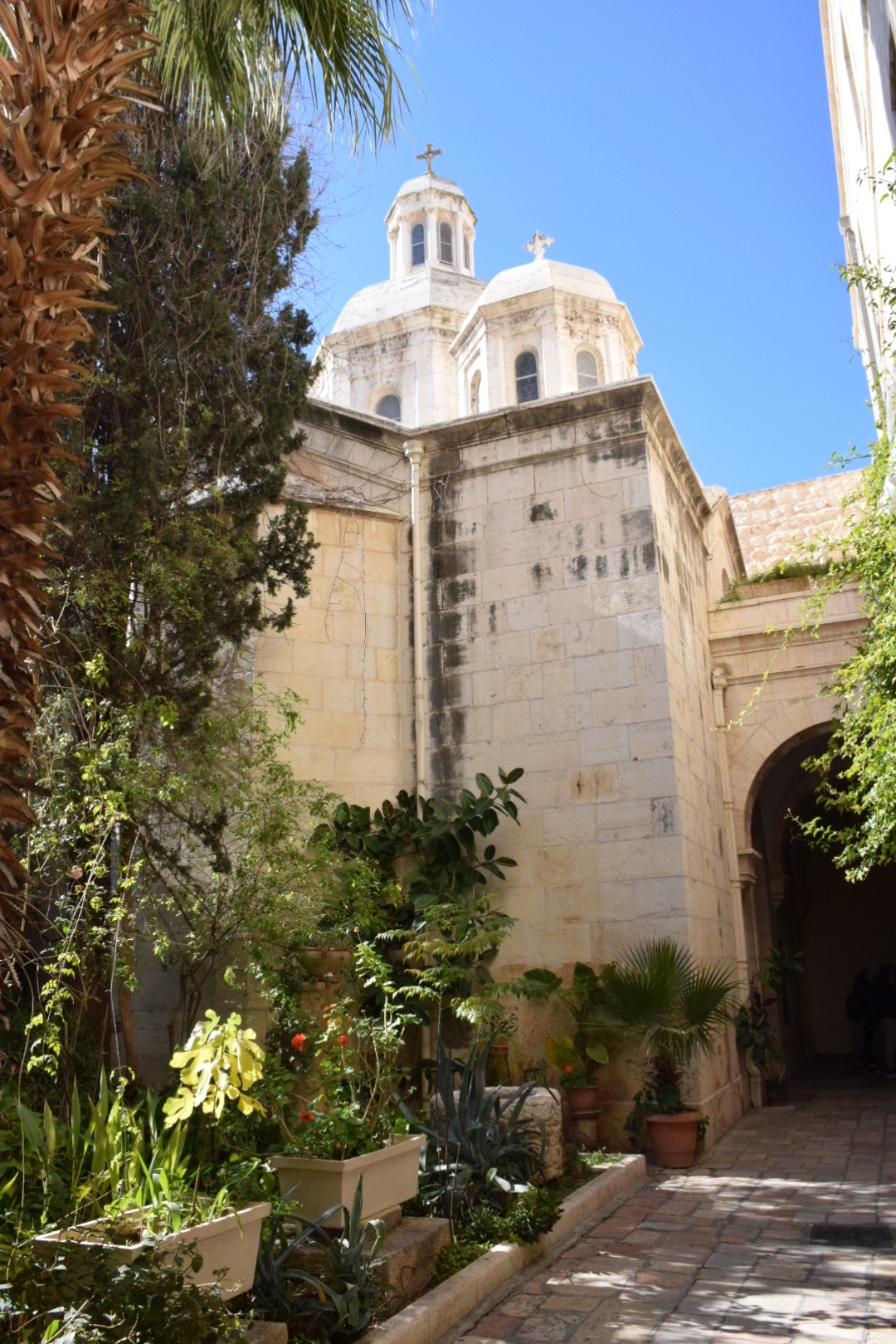
…and the Chapel of Condemnation. It is believed that these two churches are near the spot where Herod’s Fortress of Antonia was located, which is a possible place where Jesus was tried by Pilate. Murad used these to explain the 14 steps that are included in the “Way of the Cross” that was created to show the way of Jesus from his trial to burial (Matt 27: Mark 15; Luke 23; John 18:28–19:42). In reality, we don’t know the exact spot where any of these things occurred, because we don’t have any evidence from the time of Jesus. Murad explained that Jerusalem was destroyed and rebuilt and destroyed and rebuilt, and to get to times of Jesus would require destroying modern layer. Also, not all of these steps depict things that actually appear in scripture.
The first step is located within an Arab school across the street from the churches, the next two are in the area of the churches, and then the next 7 go through the streets of Jerusalem to the Church of the Holy Sepluchre. The final 5 are in the Church of the Holy Sepluchre, which is the traditional location of Cavalry and the tomb of Jesus.
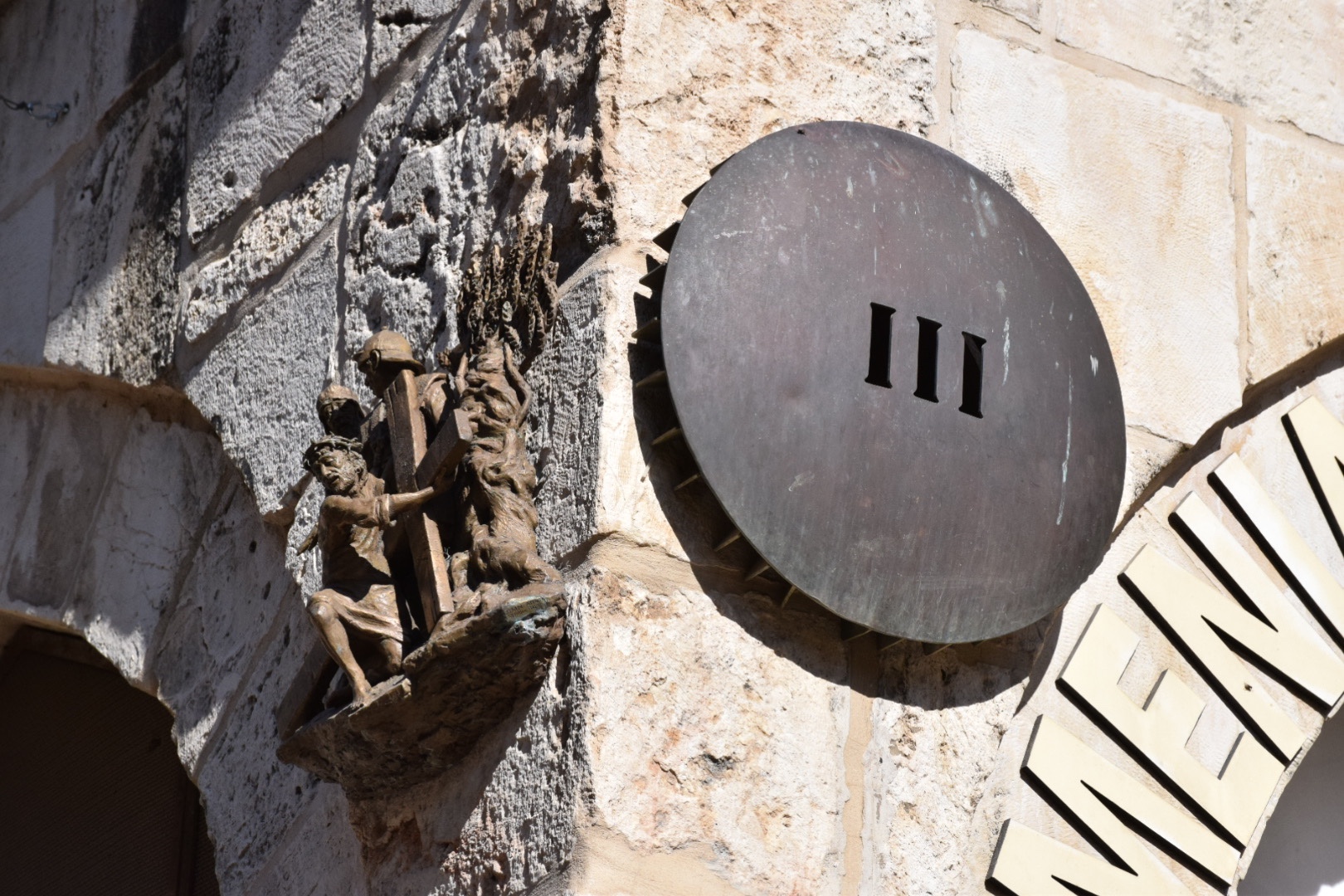
We took to the streets and followed the next few steps of the Way of the Cross through the marketplace of the Old City.
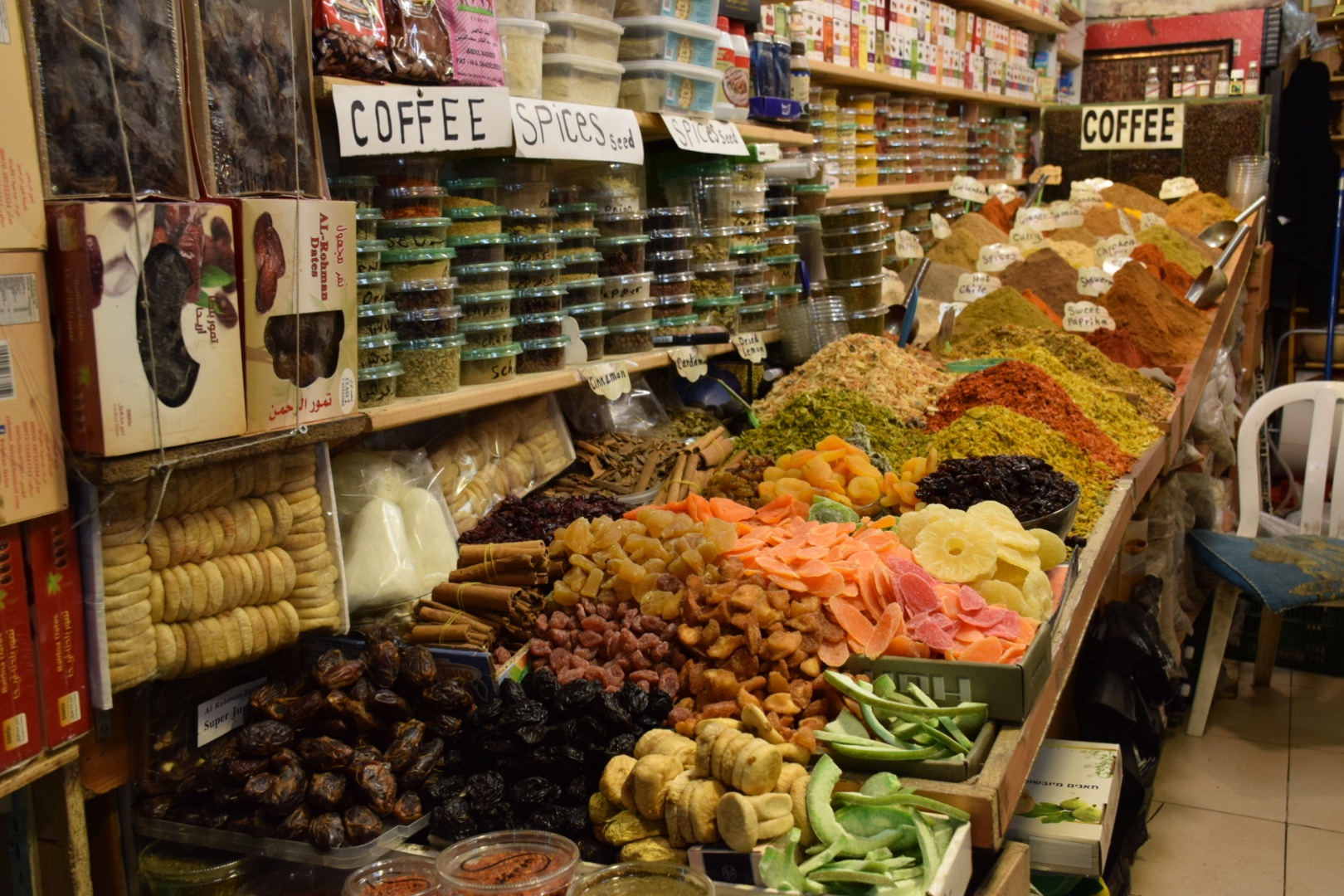
The marketplace was fascinating. Very skinny, twisting, hilly streets lined with vendors selling everything imaginable;
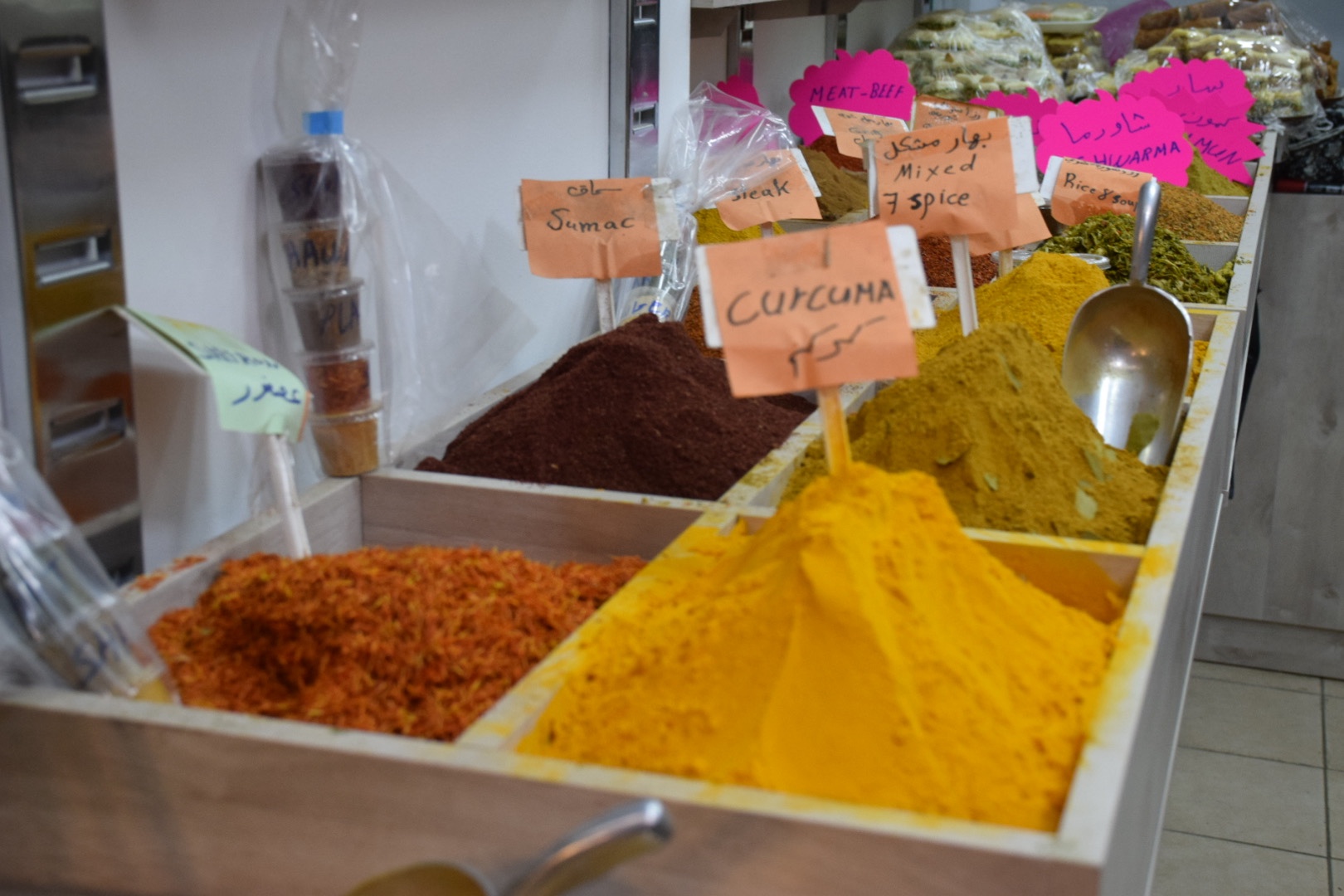
from spices, to fruit, to candy, to fake Nike shoes, to toys, to every type of trinket you can think of. Incidentally, while walking around the city, we went through three of the four quarters. This included the Muslim Quarter, the Christian Quarter and the Jewish Quarter. Murad said that the Christian Quarter was in name only, because all of the Christians have left.
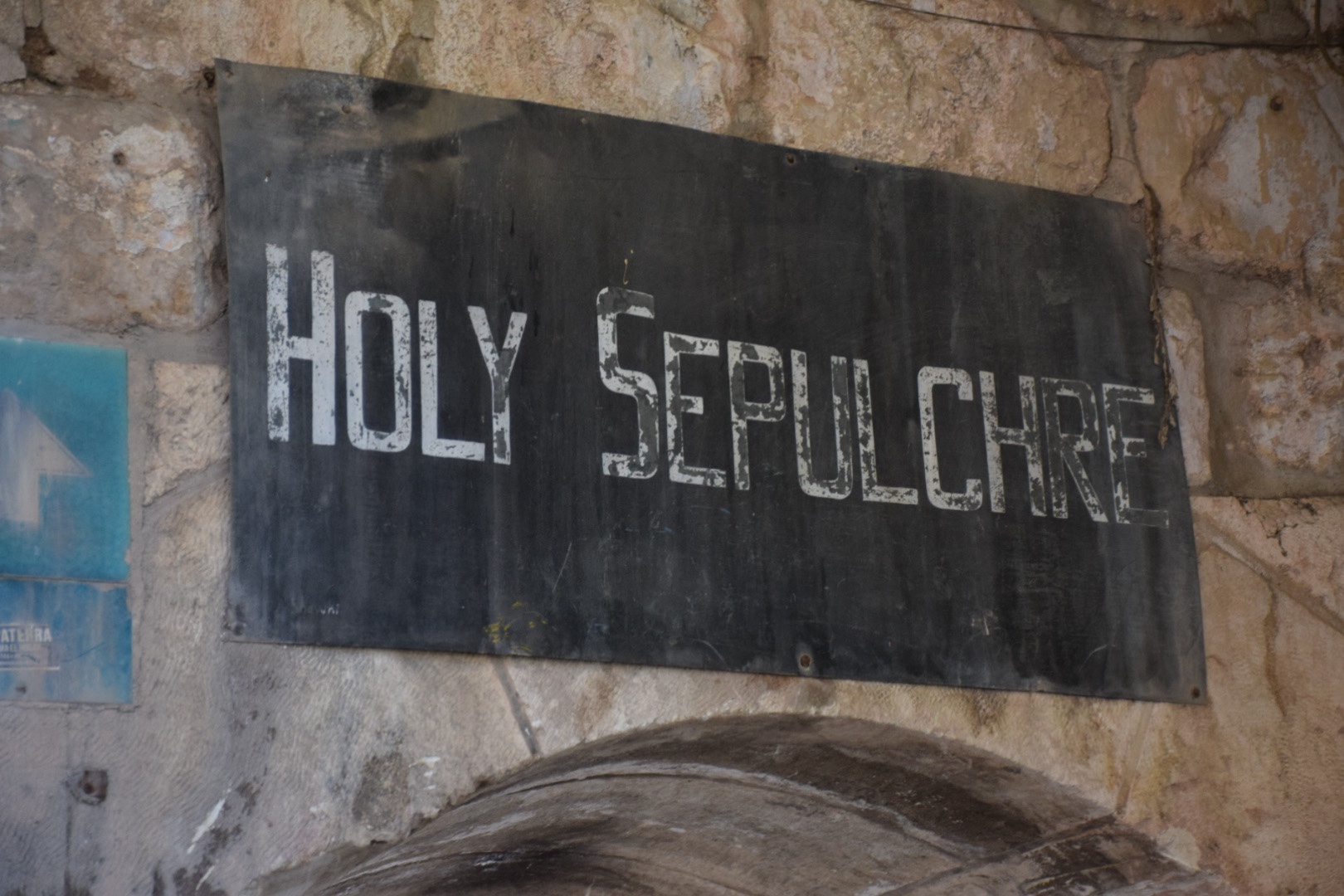
In the Christian Quarter we arrived at the Church of the Holy Sepluchre and stayed on the outside briefly before continuing on to the Jewish Quarter.
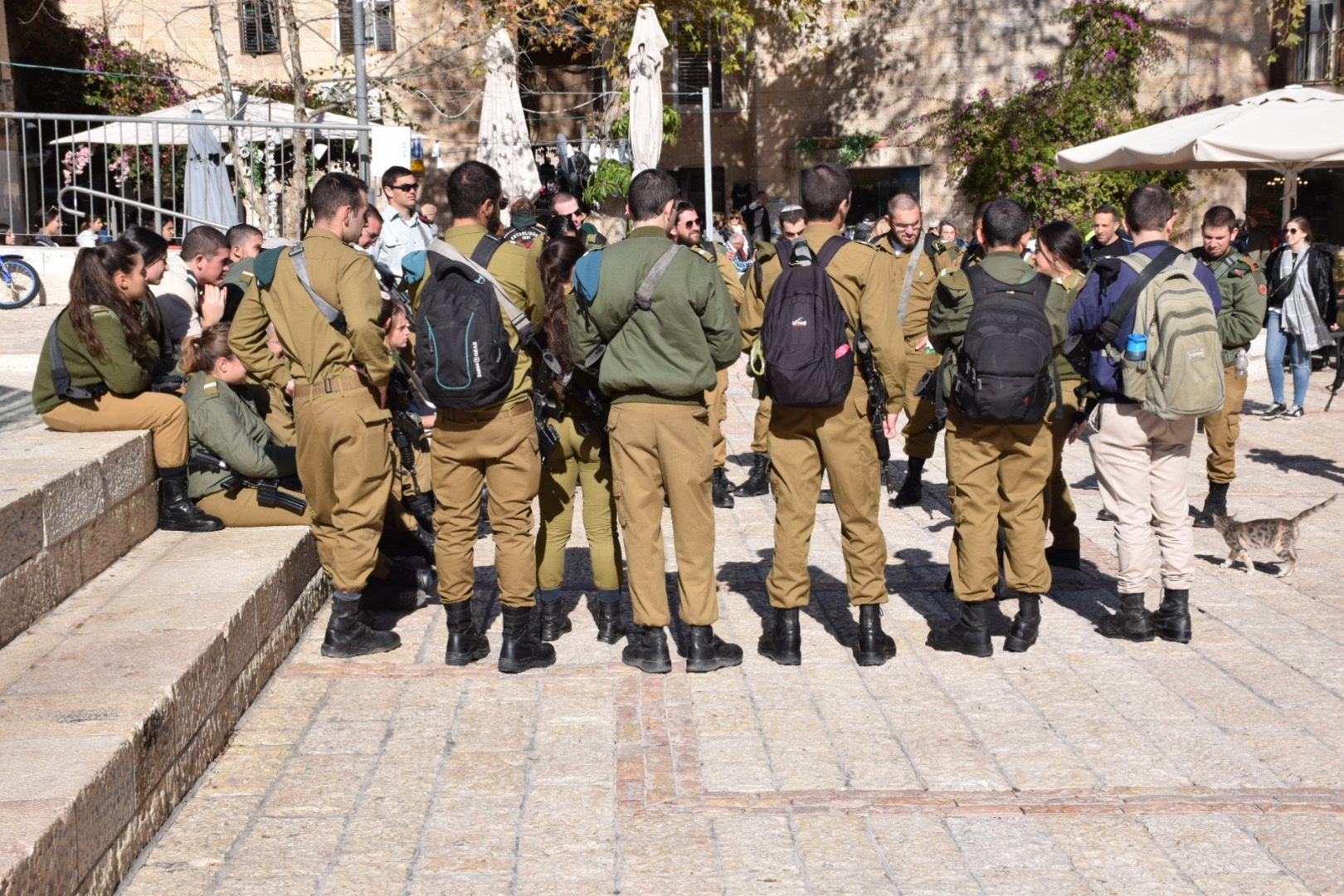
In this area, we saw lots of soldiers carrying machine guns as they were being trained in large groups about the culture of the city.
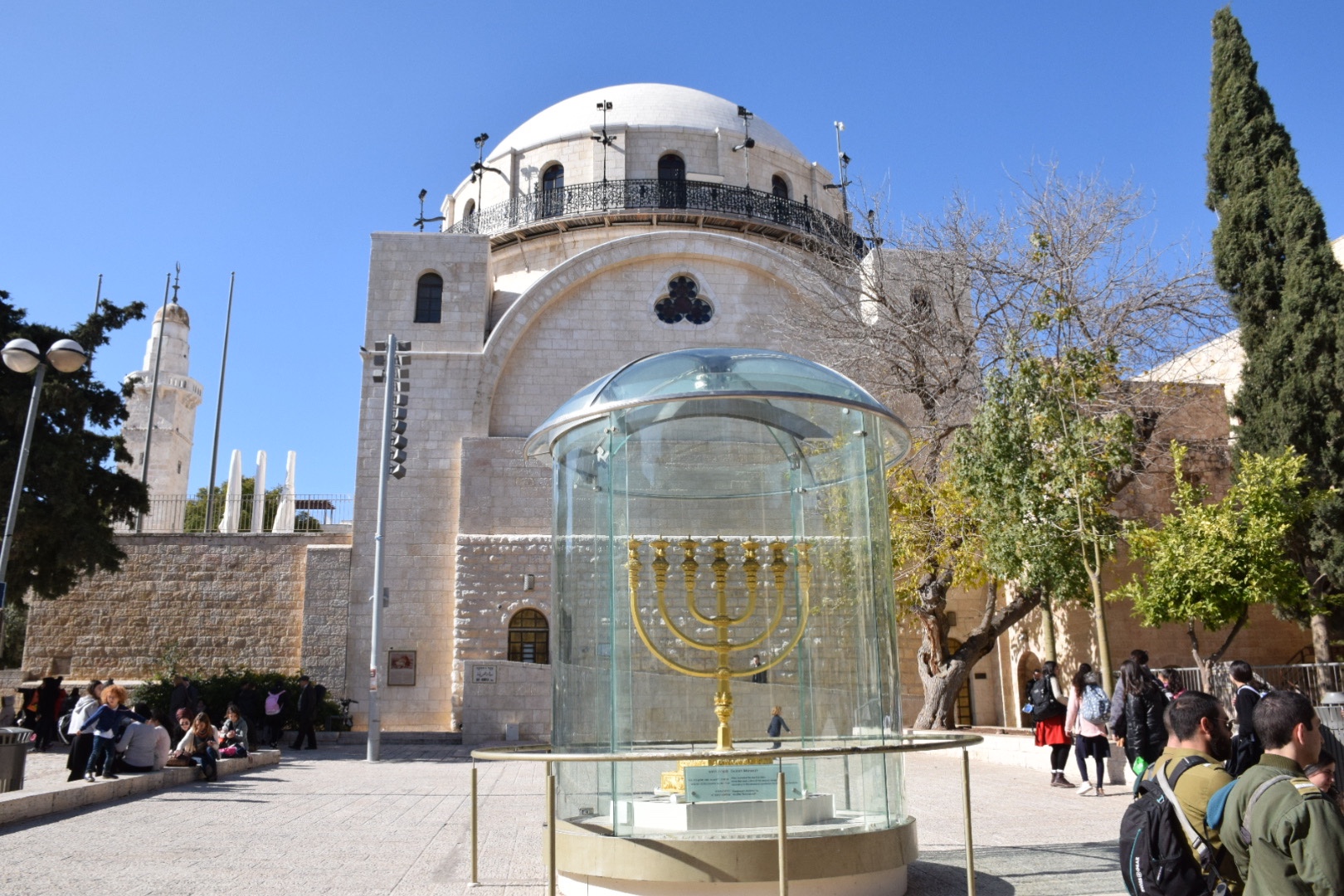
We also briefly saw the outside of the massive Haramban Synagogue.
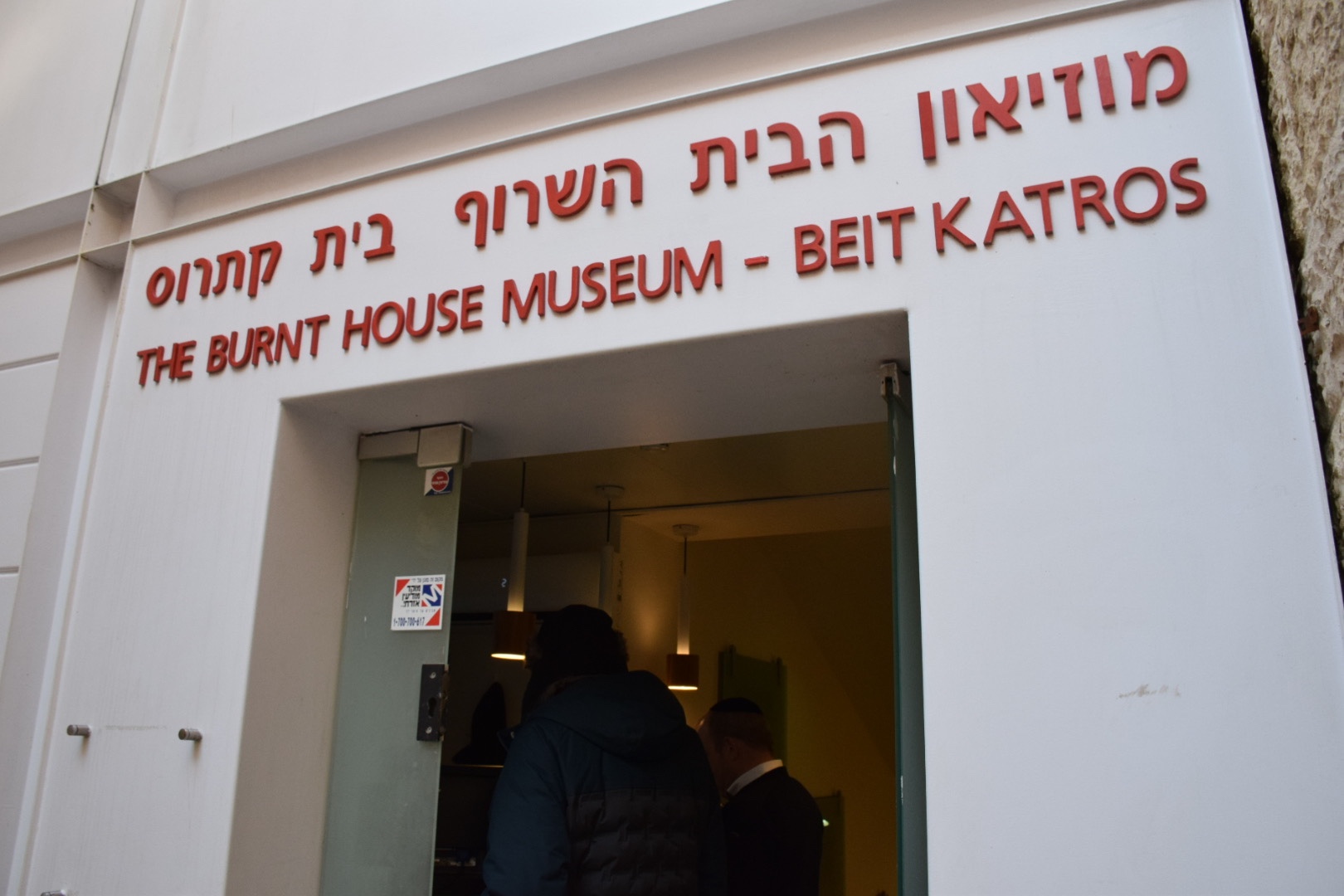
Our destination in the Jewish Quarter was the Burnt House or Beit Katros. This is a museum dedicated to the excavation of the charred remains of a house from the first century AD. It was likely burned down when the Romans destroyed Jerusalem in AD 70.
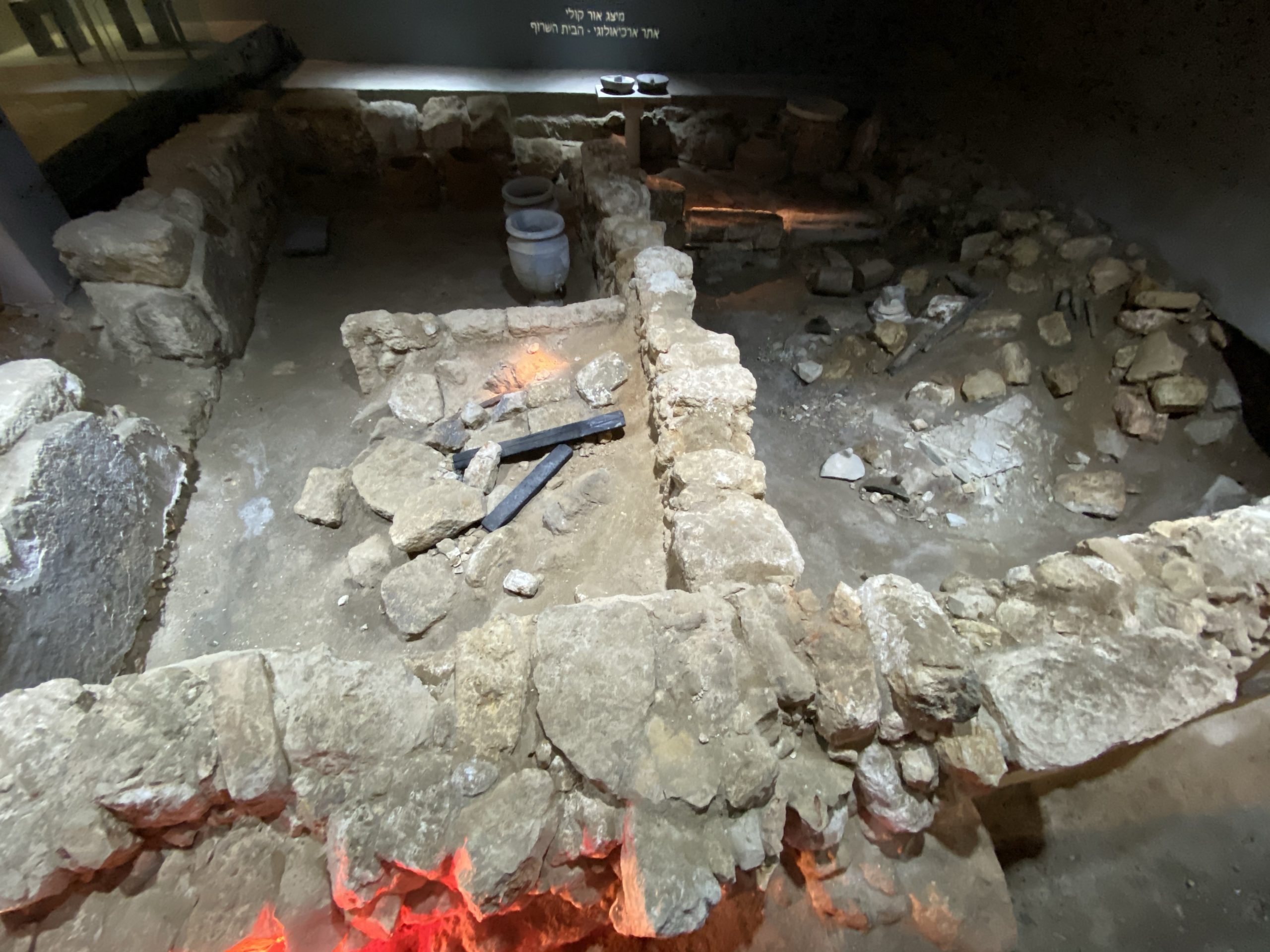
The house was excavated in 1970, and it was found in the upper city where the temple priests would have resided during this period. Inside the house, they found burned rocks and charred beams, a charred Roman spearhead made of iron, and lots of pottery and other vessels.
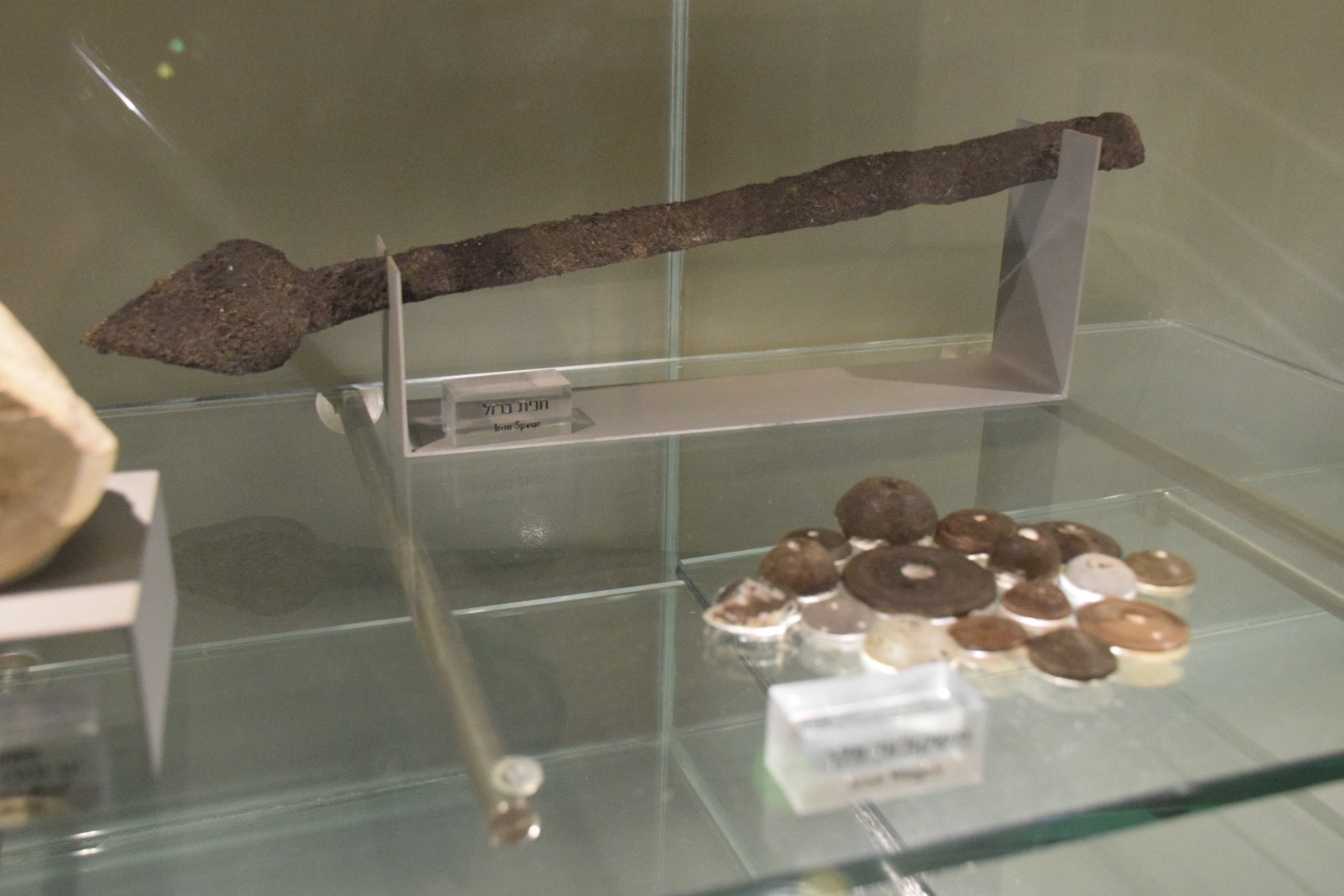
It was amazing to see this spearhead, because it made me think about the Romans piercing the side of Jesus with a spear (John 19:34). They also found a stone weight with the inscription “Katros,” which was a name identified in the Babylonian Talmud as a priest of the temple. This is why they call it Beit Katros.
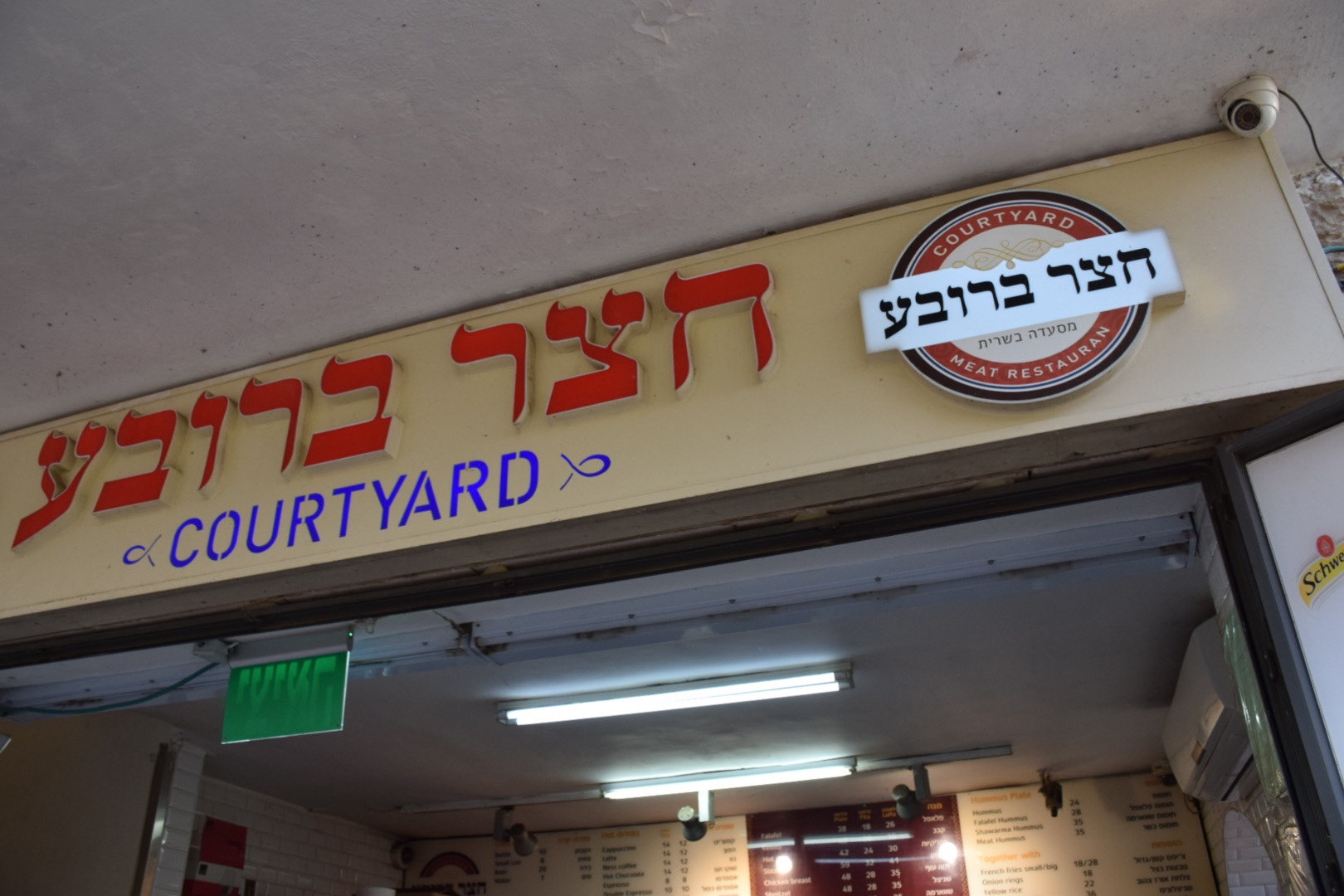
After being the Burnt House, we stayed in the Jewish Quarter for lunch on our own. I went to a restaurant with a Hebrew Name that was translated on the sign as “Meat Restaurant,” which I found quite funny. This place was chaotic, but I was able to get some grilled chicken and salad that was phenomenal. I sat with Karen and Delores at a table in the Bazaar and had a lovely conversation. When I finished lunch, I did a little shopping before meeting back up with Murad and the group.
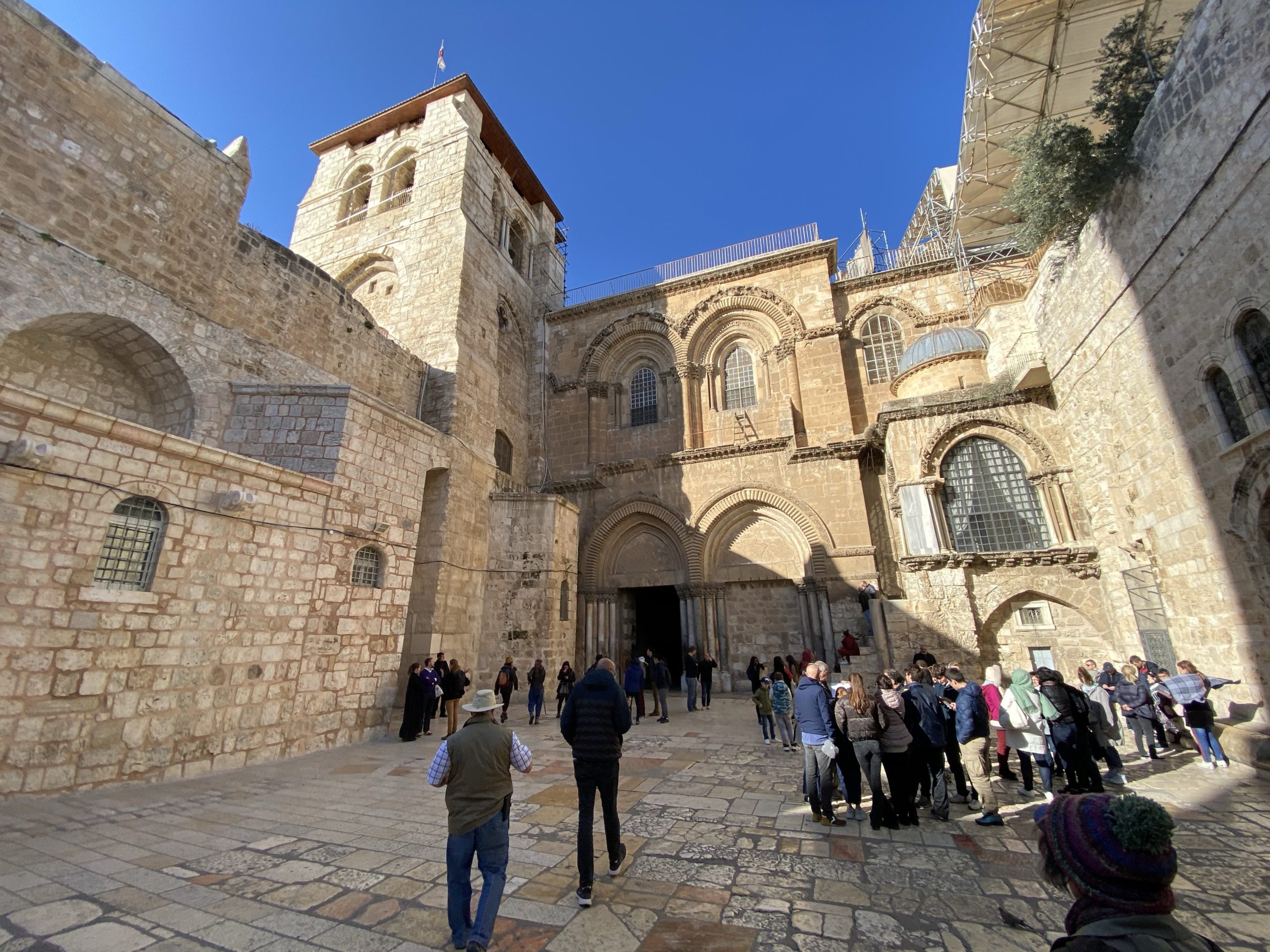
From the Jewish Quarter, we walked back to the Christian Quarter and visited the Church of the Holy Sepluchre. The structure on this site has been built and rebuilt several times from 335 AD to 1048 AD, and even through more modern times. According to traditions dating back to at least the fourth century, this Church the site where Jesus was crucified (Golgotha – Matt 27:33; Mark 15:22; John 19:17), and Jesus’s empty tomb, where he was buried and resurrected (Matt 27:57-28:10; Mark 15:42-16:8; Luke 23:50-24:12; John 19:38-20:10).
The tomb is enclosed by a 19th-century shrine called the Aedicula. The Status Quo, an understanding between religious communities dating to 1757, applies to the site.
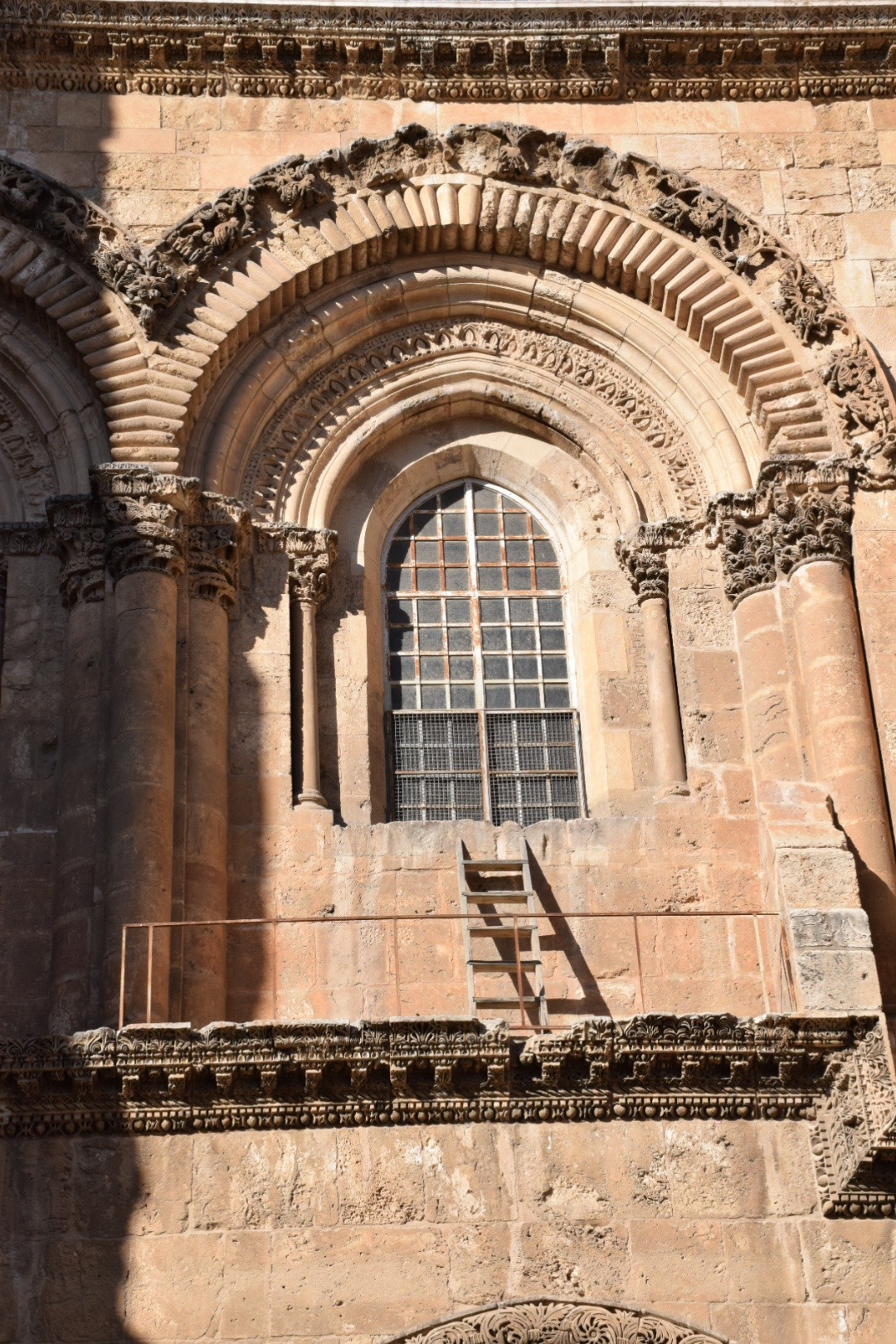
As example of Status Quo, he told us about a wooden ladder that has been propped up on the outside of the facade since 1728. The ladder is referred to as “immovable” due to the agreement of the Status Quo that no cleric of the six Christian orders may move, rearrange, or alter any property without the consent of the other five orders.
The main denominations sharing property over parts of the church are the Roman Catholic, Greek Orthodox and Armenian Apostolic, and to a lesser degree the Coptic Orthodox, Syriac Orthodox and Ethiopian Orthodox.
I imagine that if this place would have been less crowded that I would have enjoyed the visit more, as it is quite beautiful on the inside with some incredible mosaics. As it was, this place was chaos. People were shoulder to shoulder throughout the church.
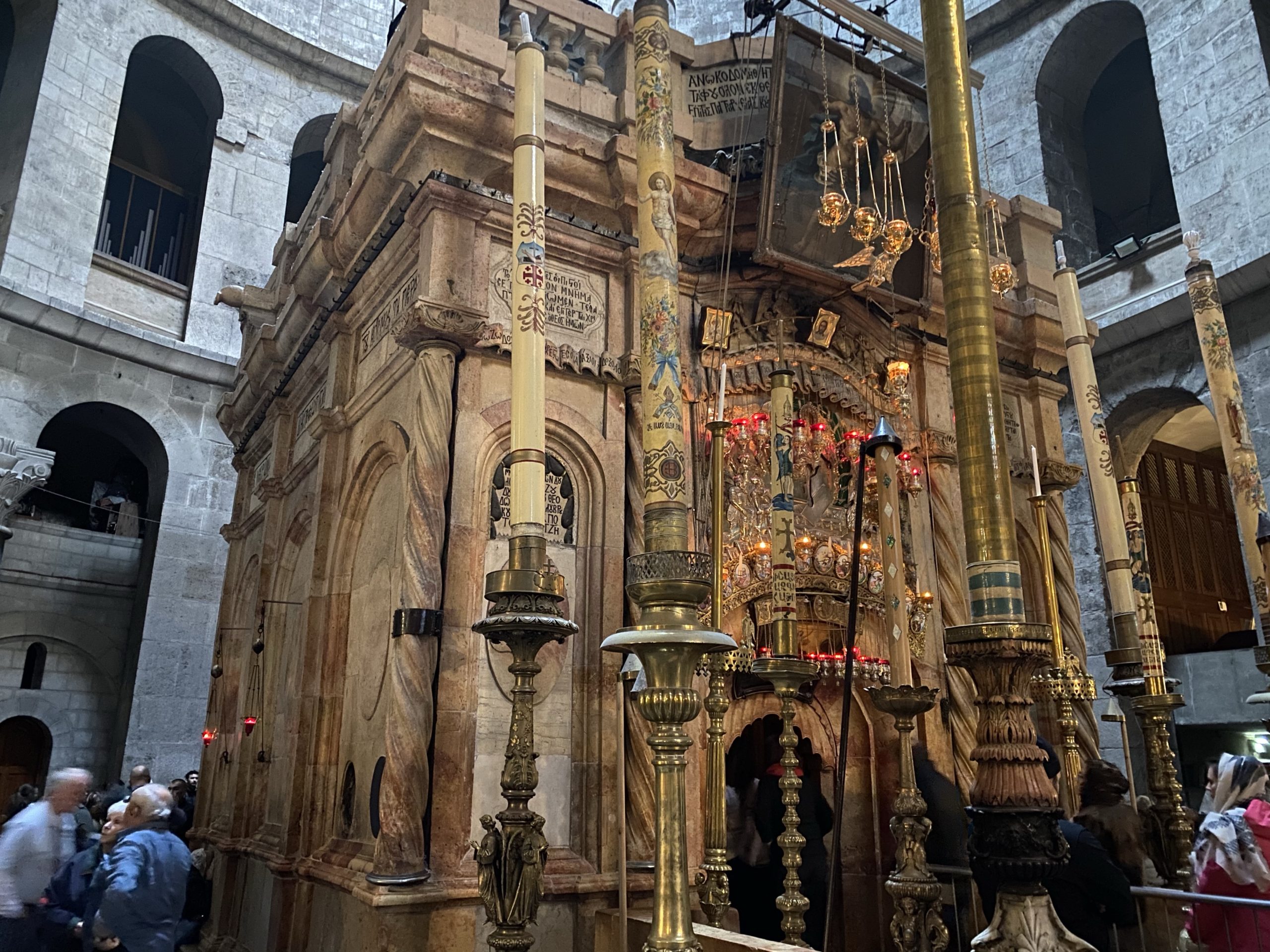
Murad took us to the Aedicula and talked to us about the tomb beneath. There were long lines of people waiting to get into the Aedicula.
Murad reiterated that archaeology cannot prove the location where Jesus was actually buried, but he said that this leaves room for faith. This was a comment that I really appreciated. Jesus himself told Thomas “Have you believed because you have seen me? Blessed are those who have not seen and yet have believed.” (Jn 20:29). This is the nature of faith (Heb 11:1). Murad also talked about how corrupt this place was, with priests accepting bribes to bypass the lines for the Aedicula or Golgotha. He compared it to what was happening in the temple when Jesus overturned the tables of the money changers.
From the Aedicula, we went back toward the entrance and climbed a very steep staircase to see “Golgotha.”
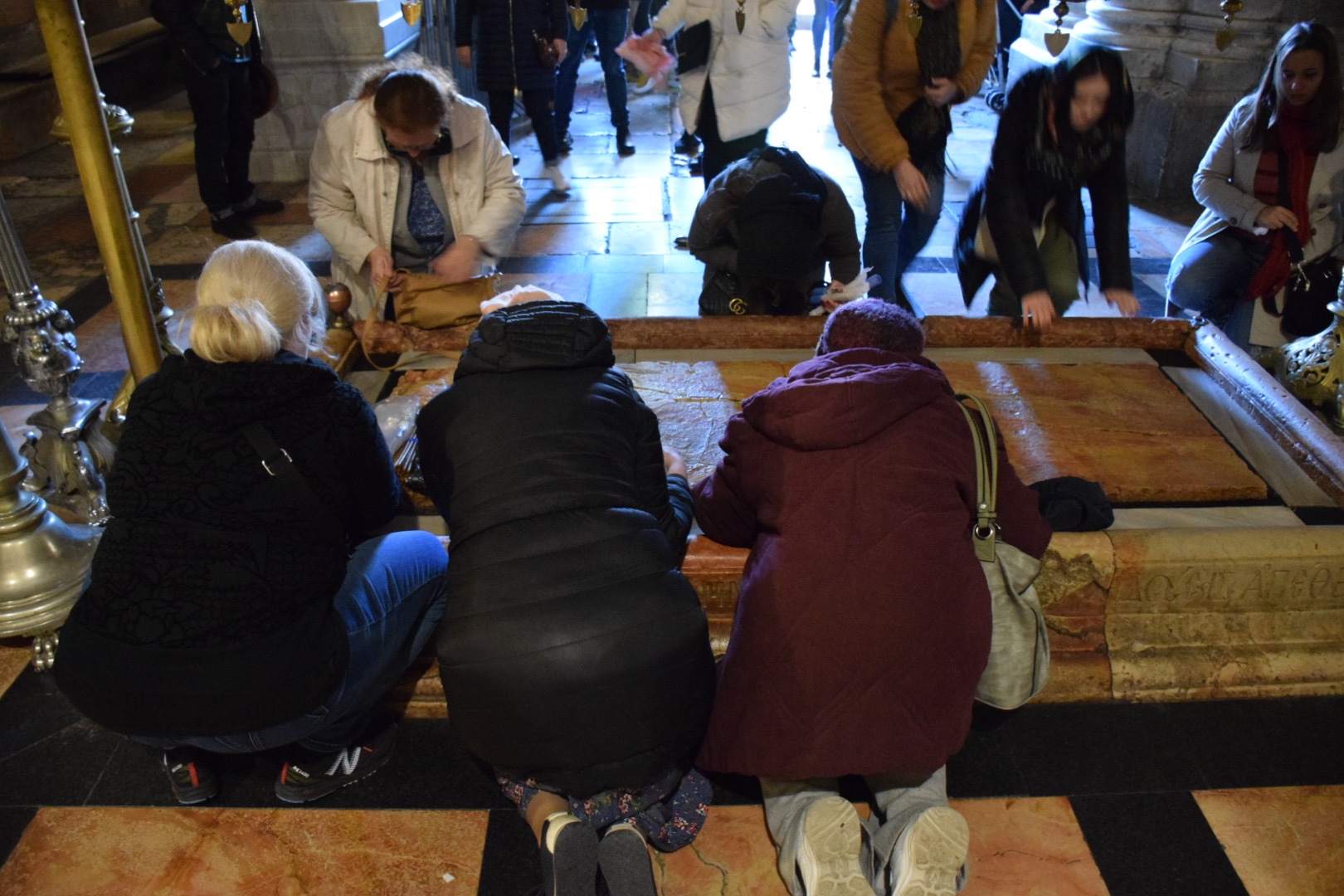
Along the way we saw the traditional stone in the floor where the body of Jesus was supposedly anointed prior to being placed in the tomb. Lots of people were kneeling to kiss the stone. There were beautiful mosaics in the area behind the stone depicting…
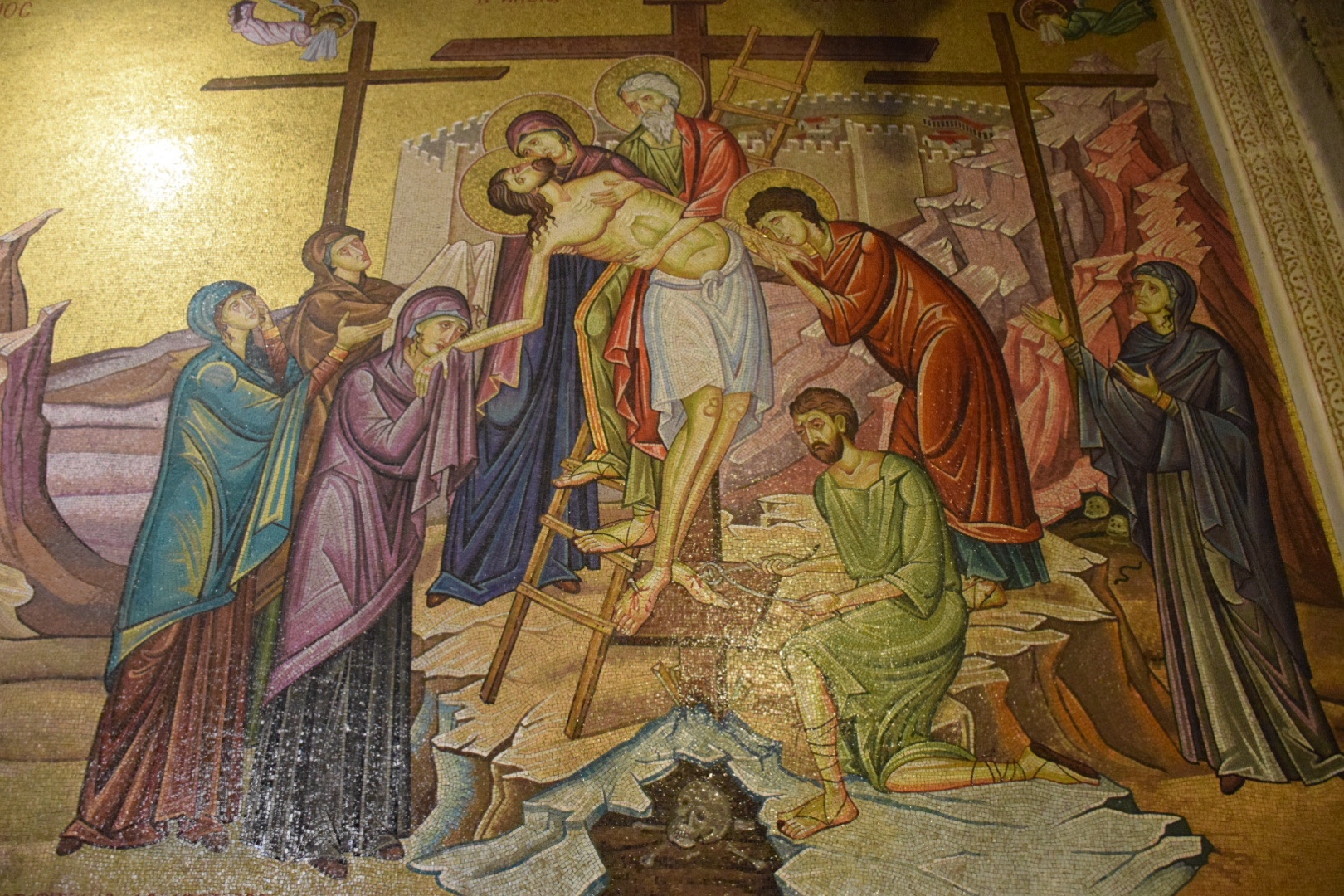
Jesus being taken down from the cross,
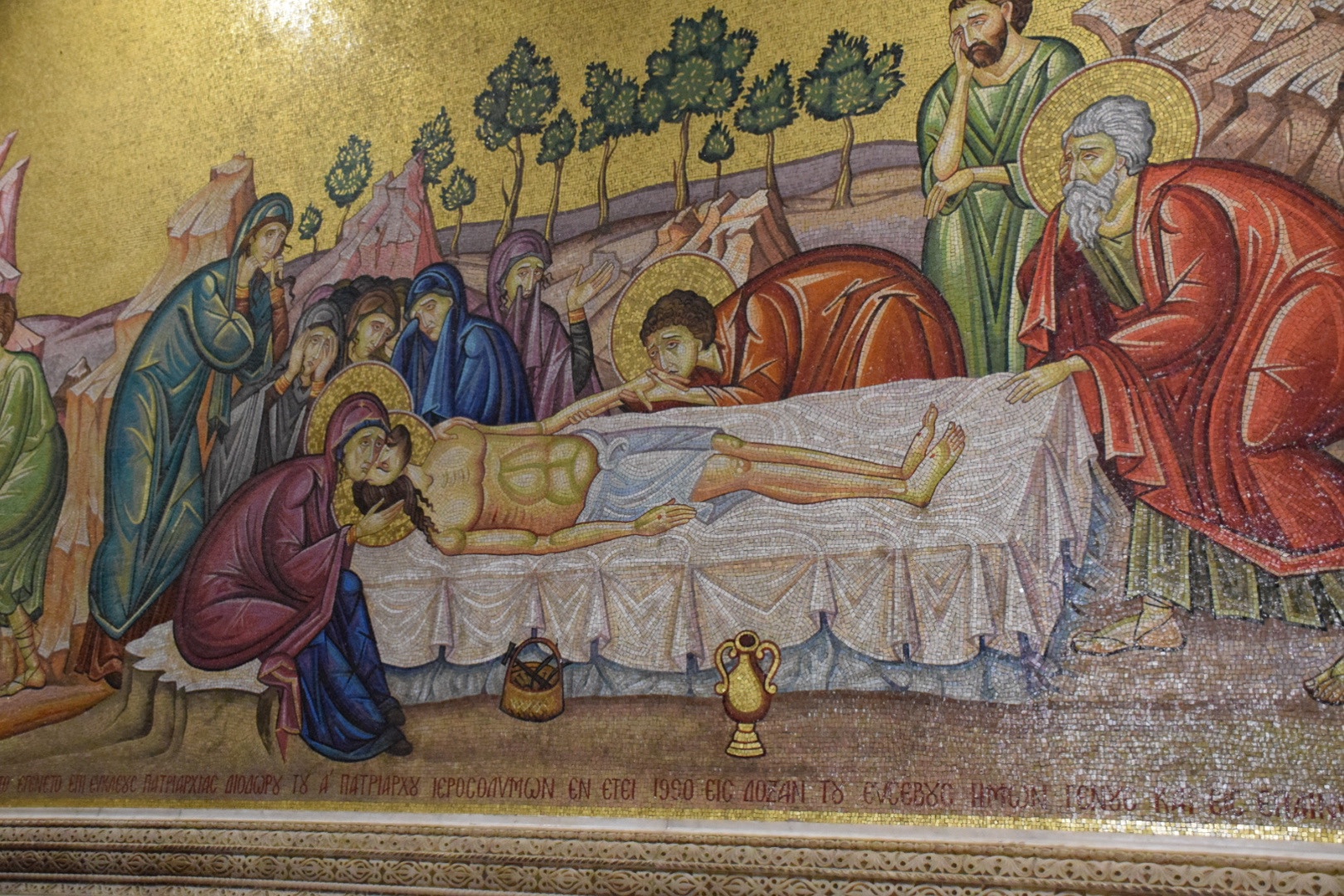
Jesus being anointed, and
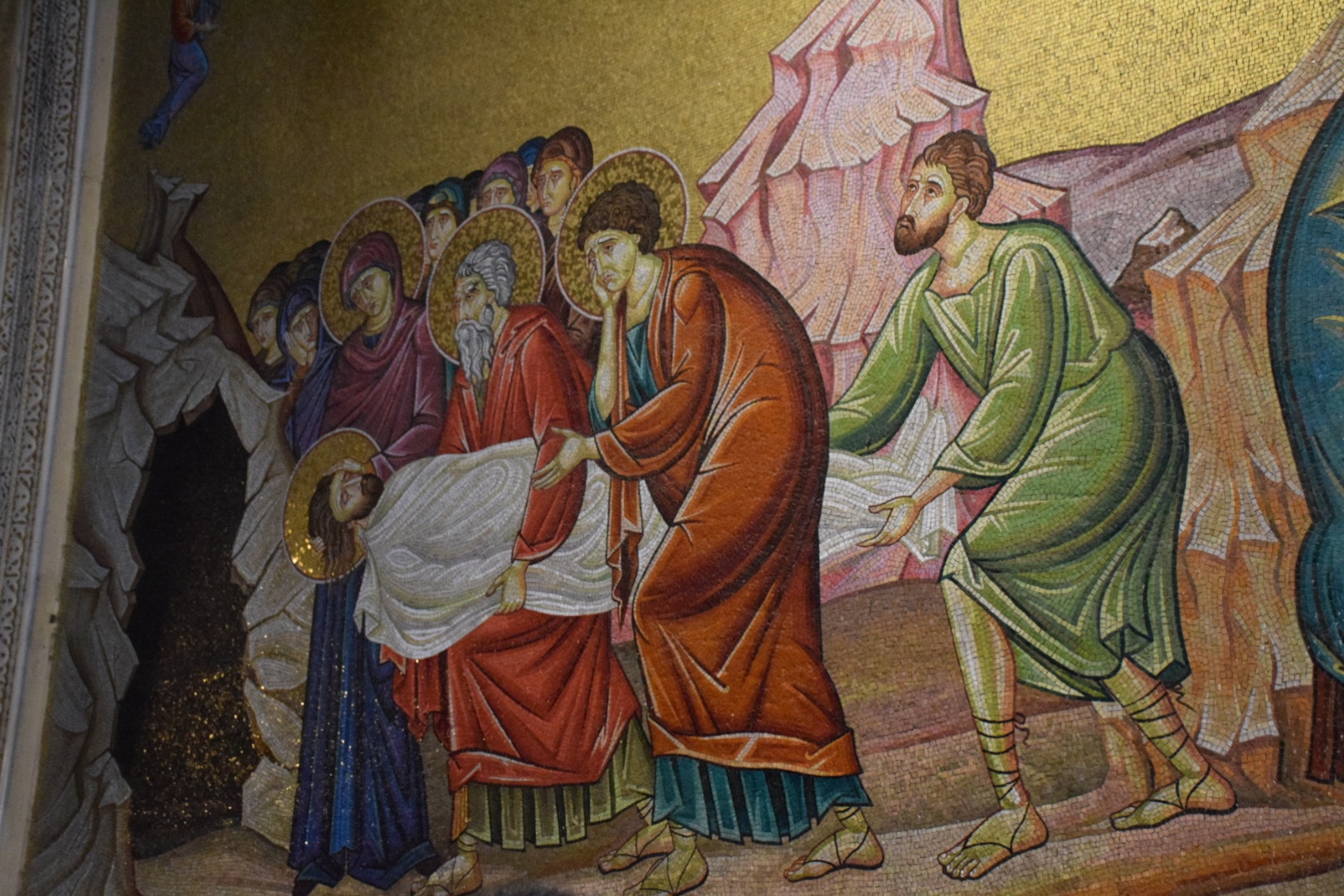
Jesus’ body being placed in the tomb.
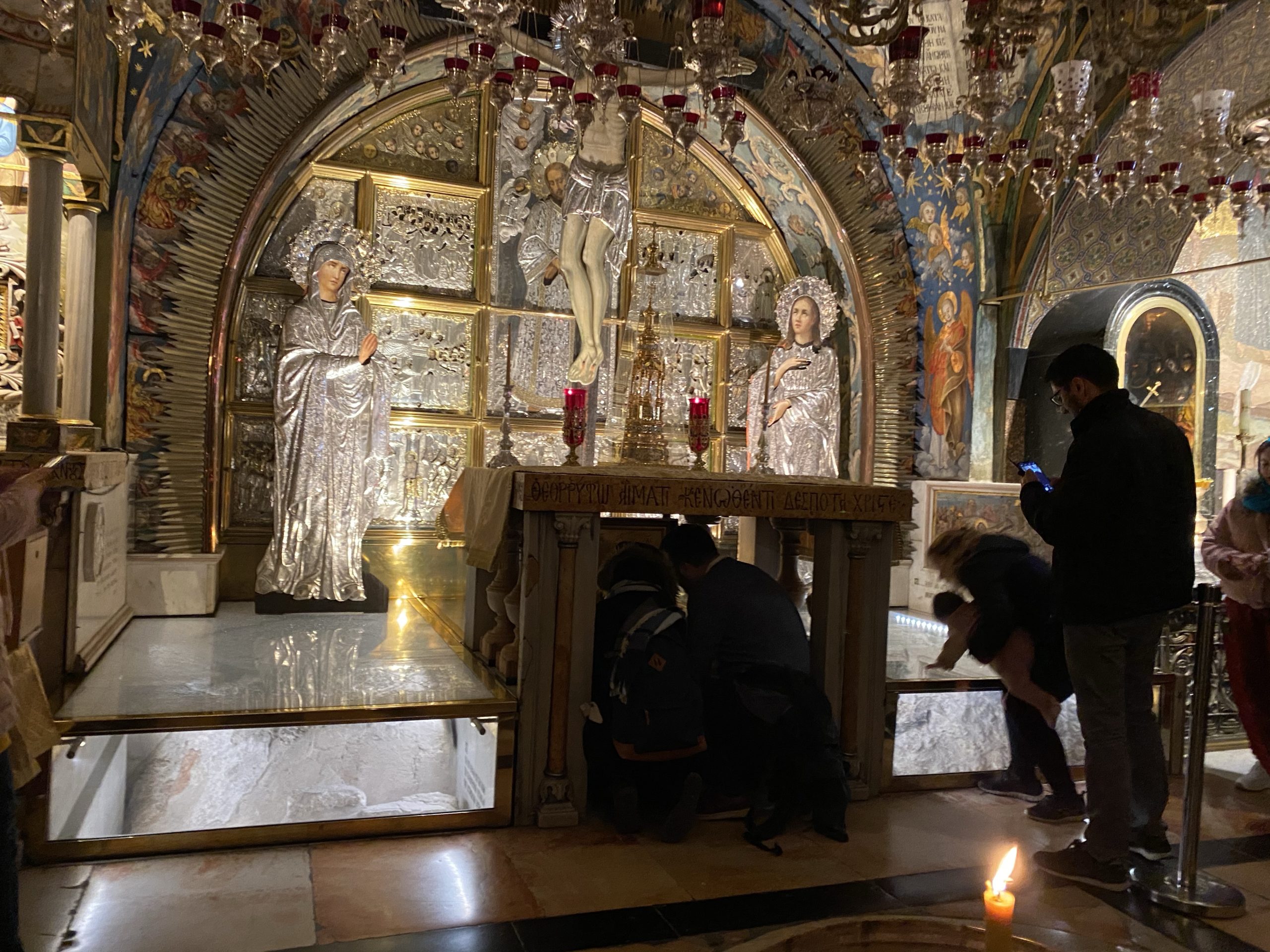
Upstairs, we saw the traditional location of “Golgotha” and the rock of Cavalry that people were waiting in line to touch and kiss. Again, this area was surrounded by beautiful mosaics.
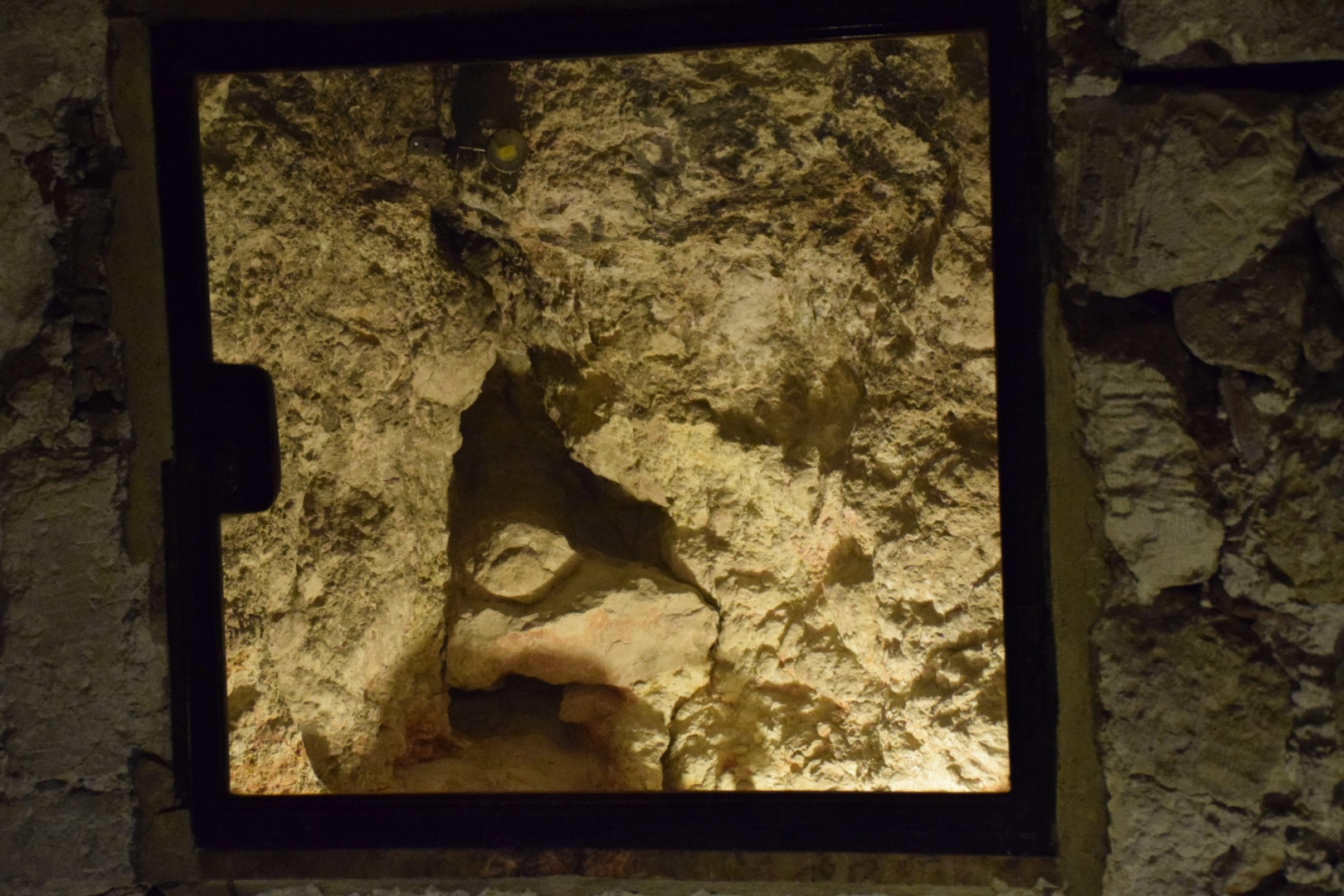
Back downstairs we saw the traditional crack that formed with the earthquake upon the death of Jesus (Matt 27:51).
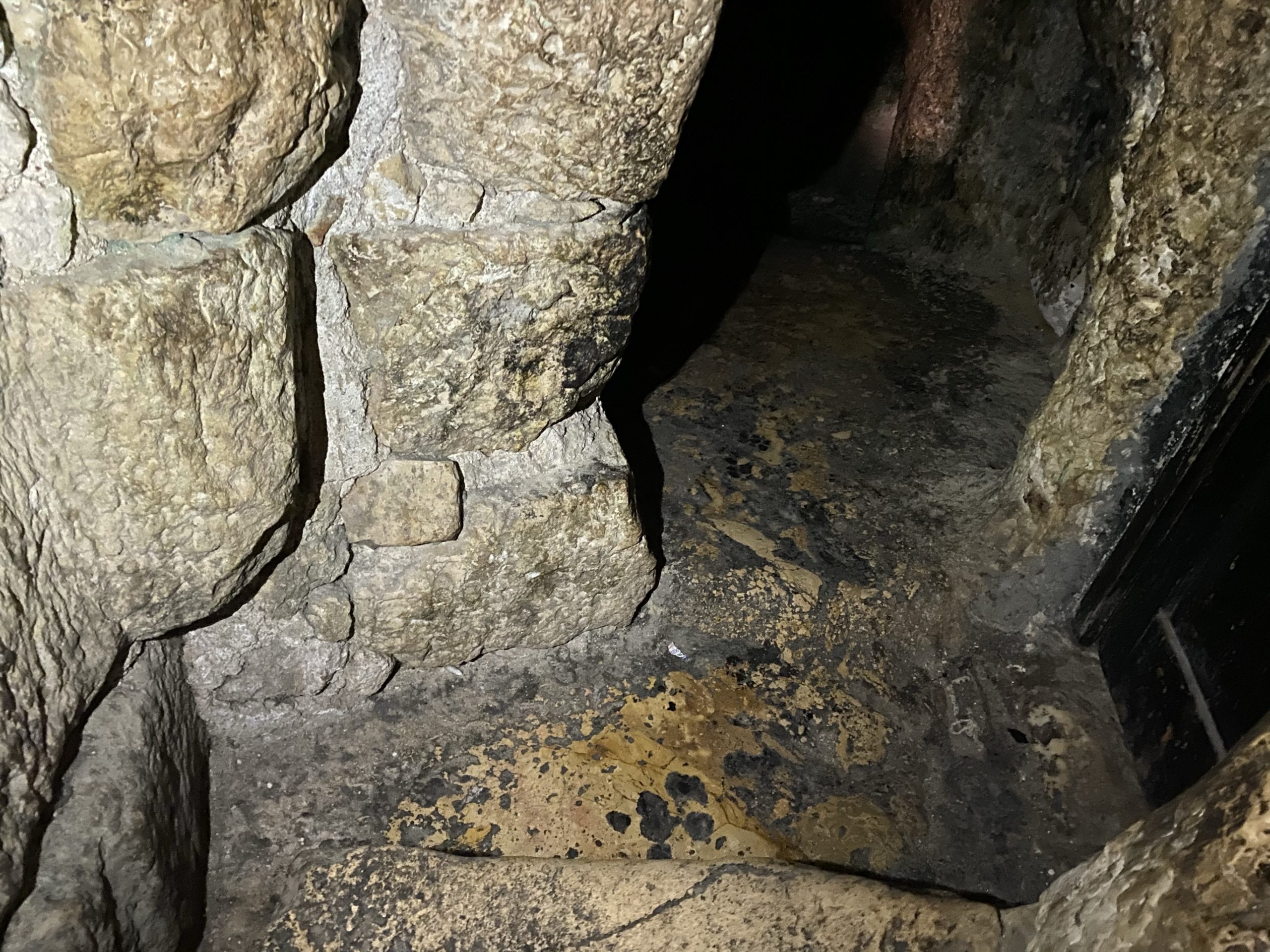
Downstairs near the Aedicula, Murad showed us an actual tomb from the time of Jesus that is traditionally identified as the place where Joseph of Arimathea was buried. We don’t know whose tomb it is, but it is a good example of a private tomb of the time. You could clearly see the track for the rolling stone.
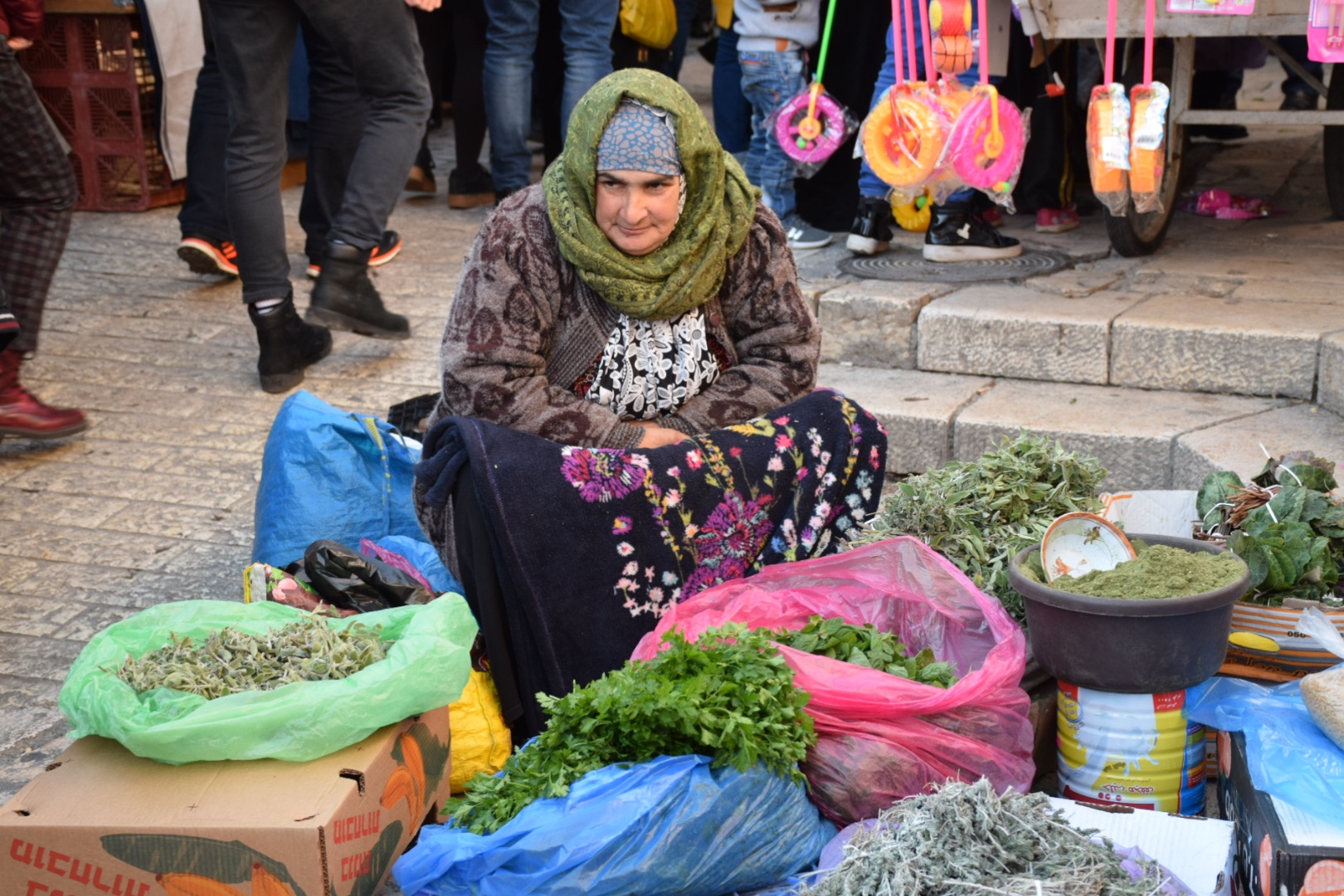
We left the Church of the Holy Sepluchre and headed back through the market area in the Muslim Quarter to the Damascus Gate.
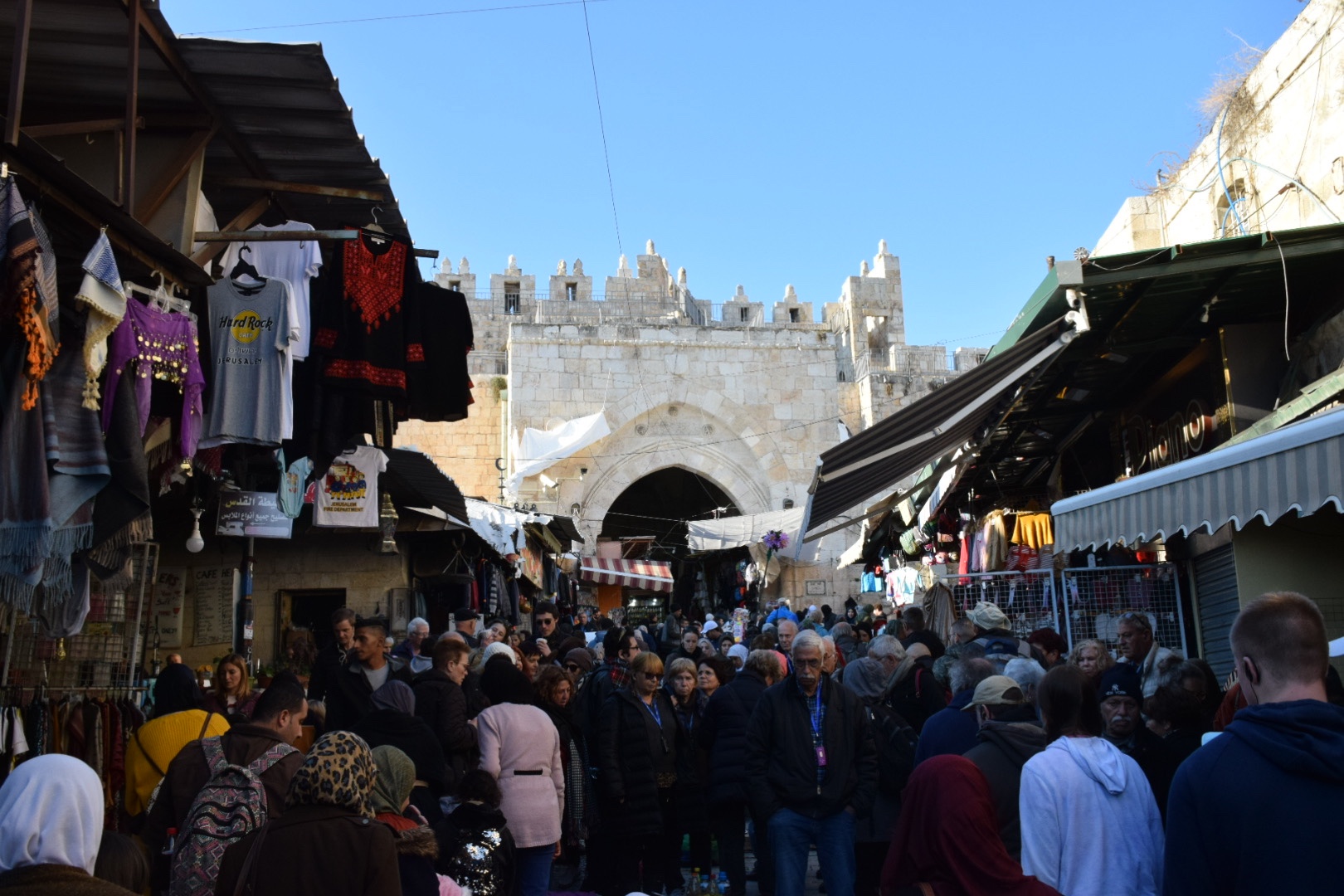
This walk was difficult due to the congestion on the narrow streets. I’ve never seen congestion like that, even in Manhattan.
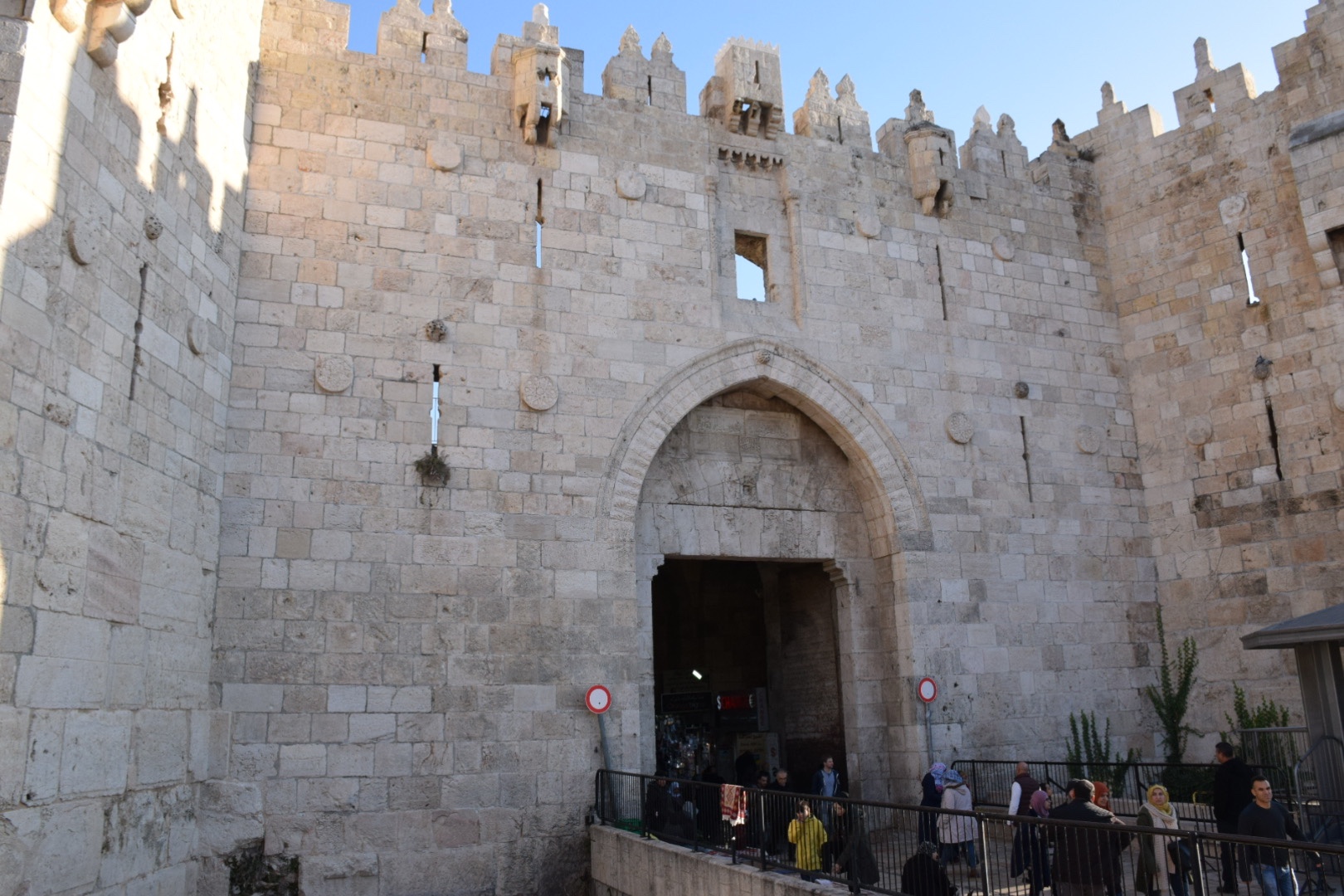
We exited the Old City through the Damascus Gate and Murad told us a little about this gate, which is one of the main entrances to the Old City of Jerusalem. It is located city’s northwest side and connects to a highway leading out to Shechem and from there to the Damascus.
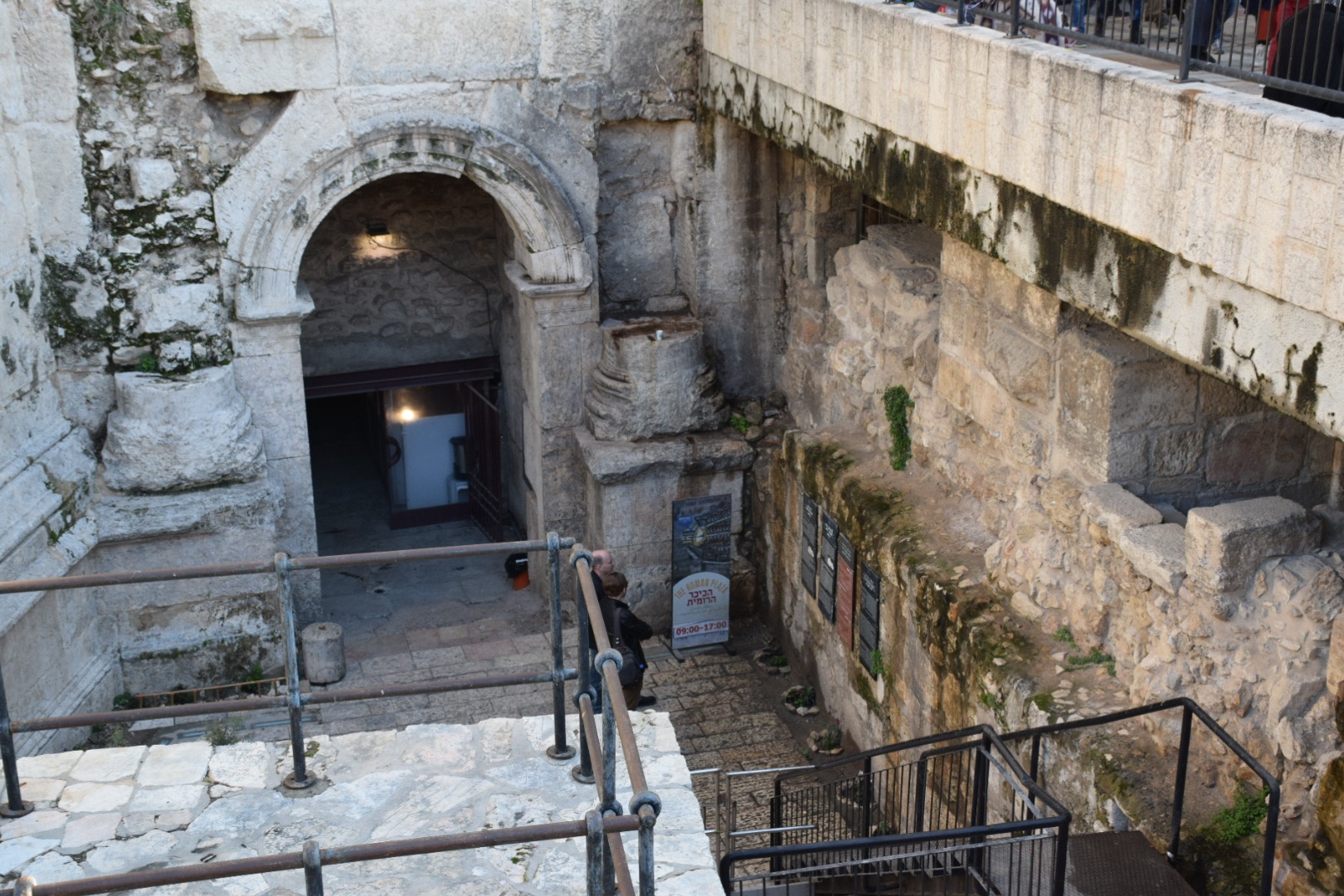
Beneath the current gate, and to the left, there are the remains of an earlier gate dating back to the time of the Roman Emperor Hadrian, who visited the region in 130–131 BC.
Garden Tomb
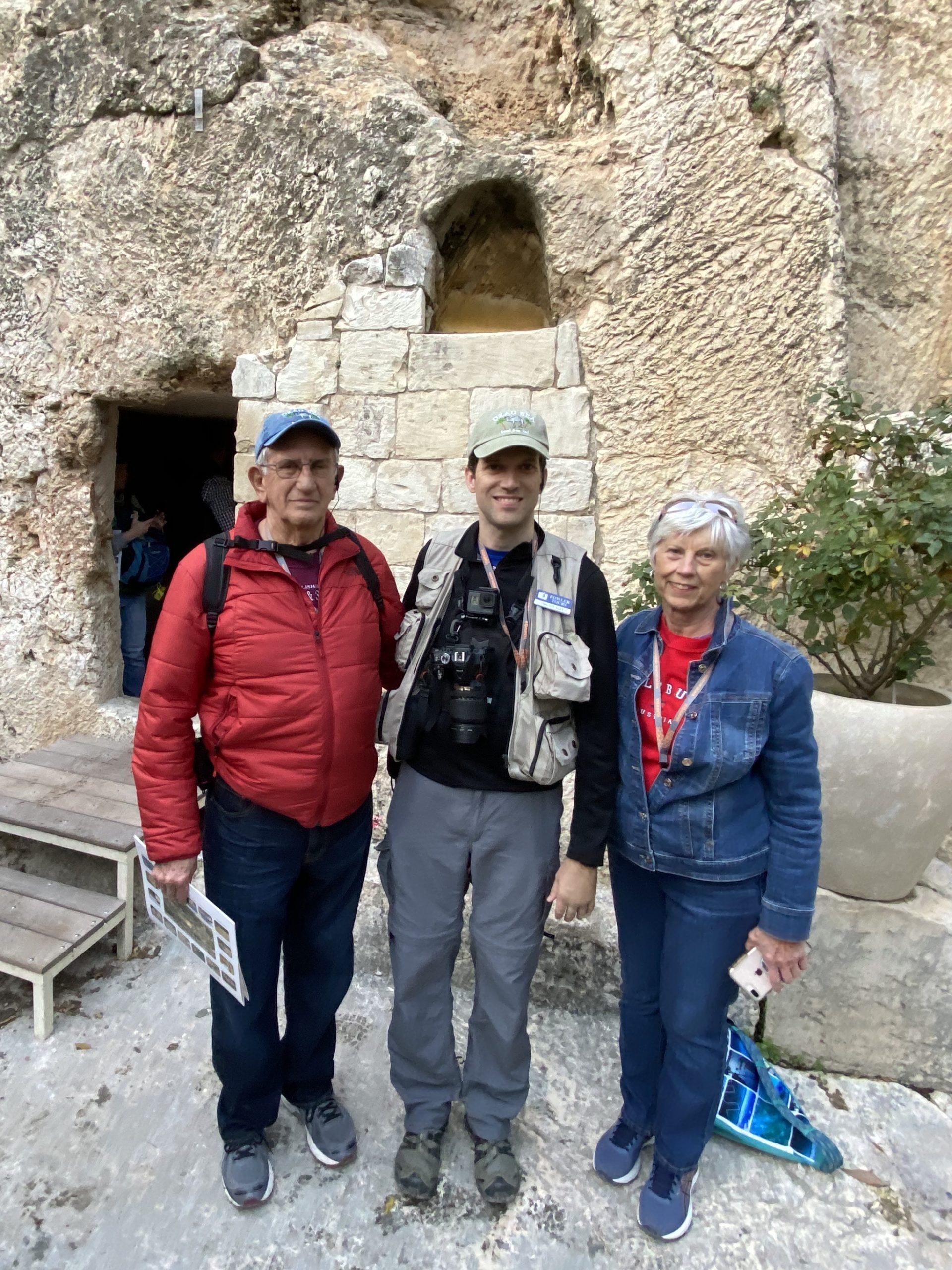
From the Damascus Gate, we continued walking outside the walls of the Old City to the Garden Tomb. On this site in the late 1800s was discovered a tomb from the time of Jesus. The site was established due to doubts about whether or not the tomb under the Church of the Holy Sepluchre was the true burial place of Christ since it was inside the city walls. However, it was determined later that the location of the Church of the Holy Sepluchre would have been outside the walls of Jerusalem as they stood in the time of Jesus.
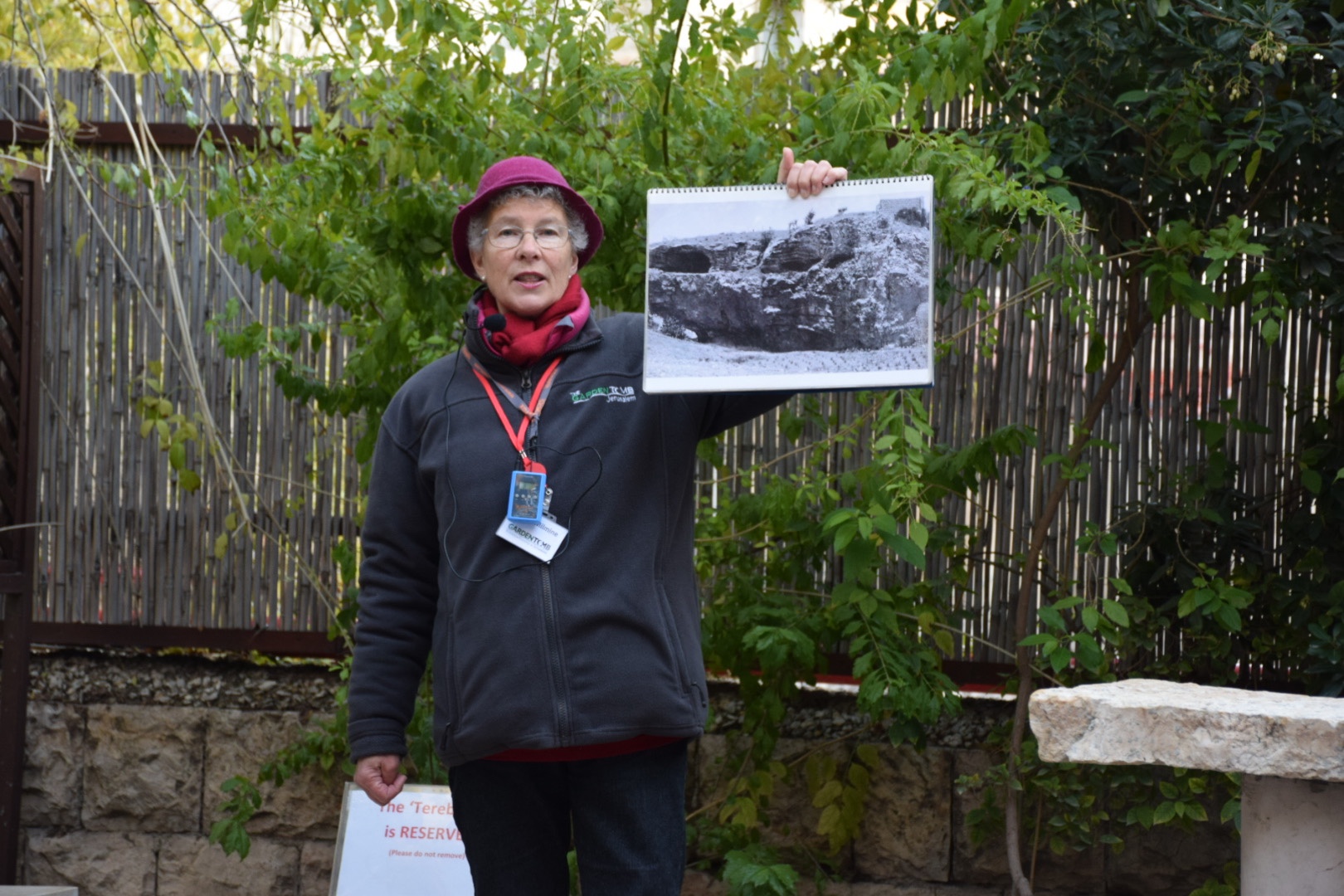
The tomb was in a beautiful garden, and upon our arrival we were met by Jenny from New Zealand who was our guide. She explained much of what I wrote above and said that whether or not it is the actual tomb of Jesus it is a great visual aid for understanding the biblical account of the burial and resurrection (Matt 27:57-28:10; Mark 15:42-16:8; Luke 23:50-24:12; John 19:38-20:10), because this tomb has features that line up with description in scripture. She also explained that part of the reason why people think this is the tomb of Jesus is because it was located near a rock hill that bears a vague resemblance to a skull.
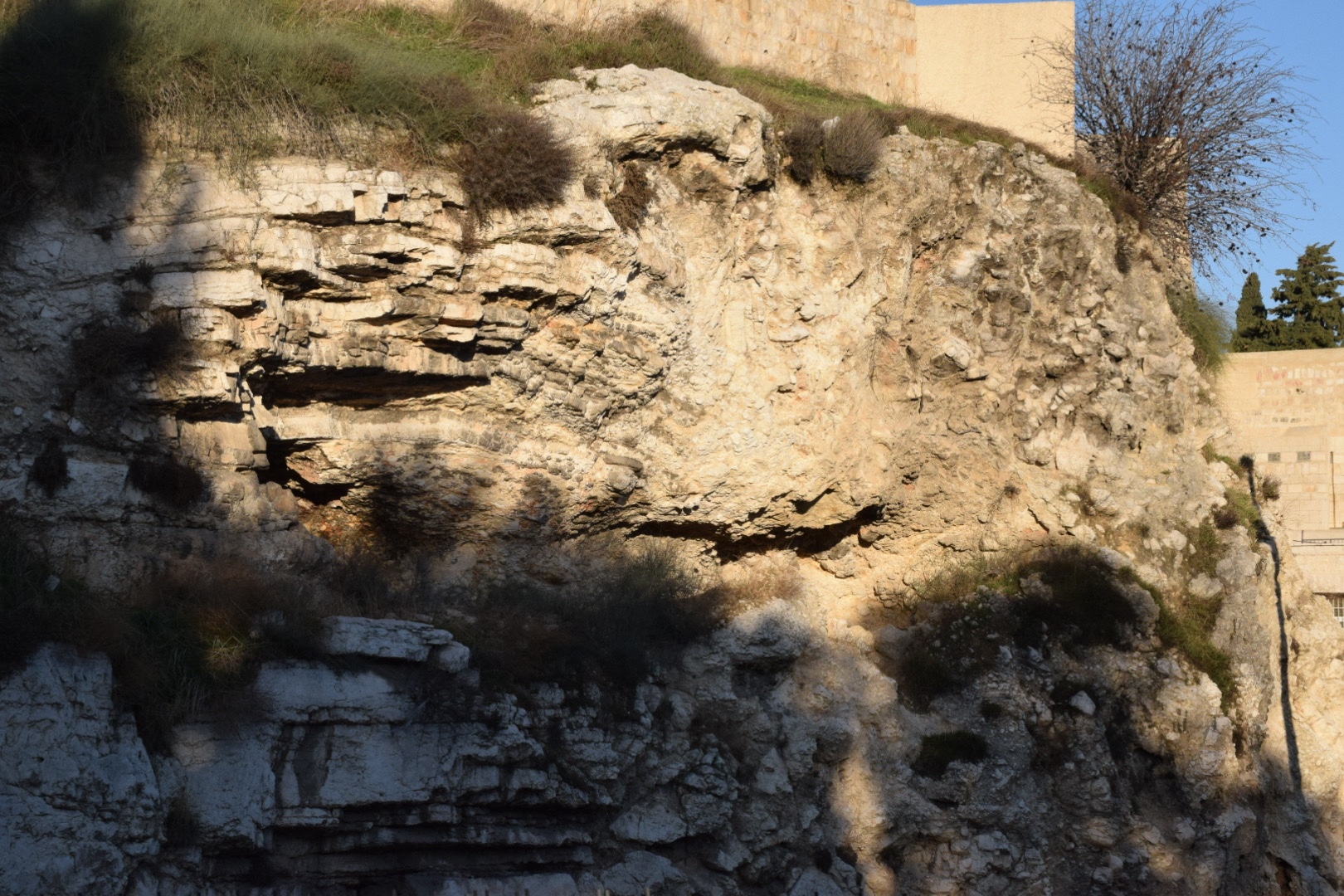
Before we moved on to look at the rock hill, Keith led us in When I Survey the Wondrous Cross and Jenny even joined us in singing. We took a quick look at the rock hill and the proceeded on to the tomb.
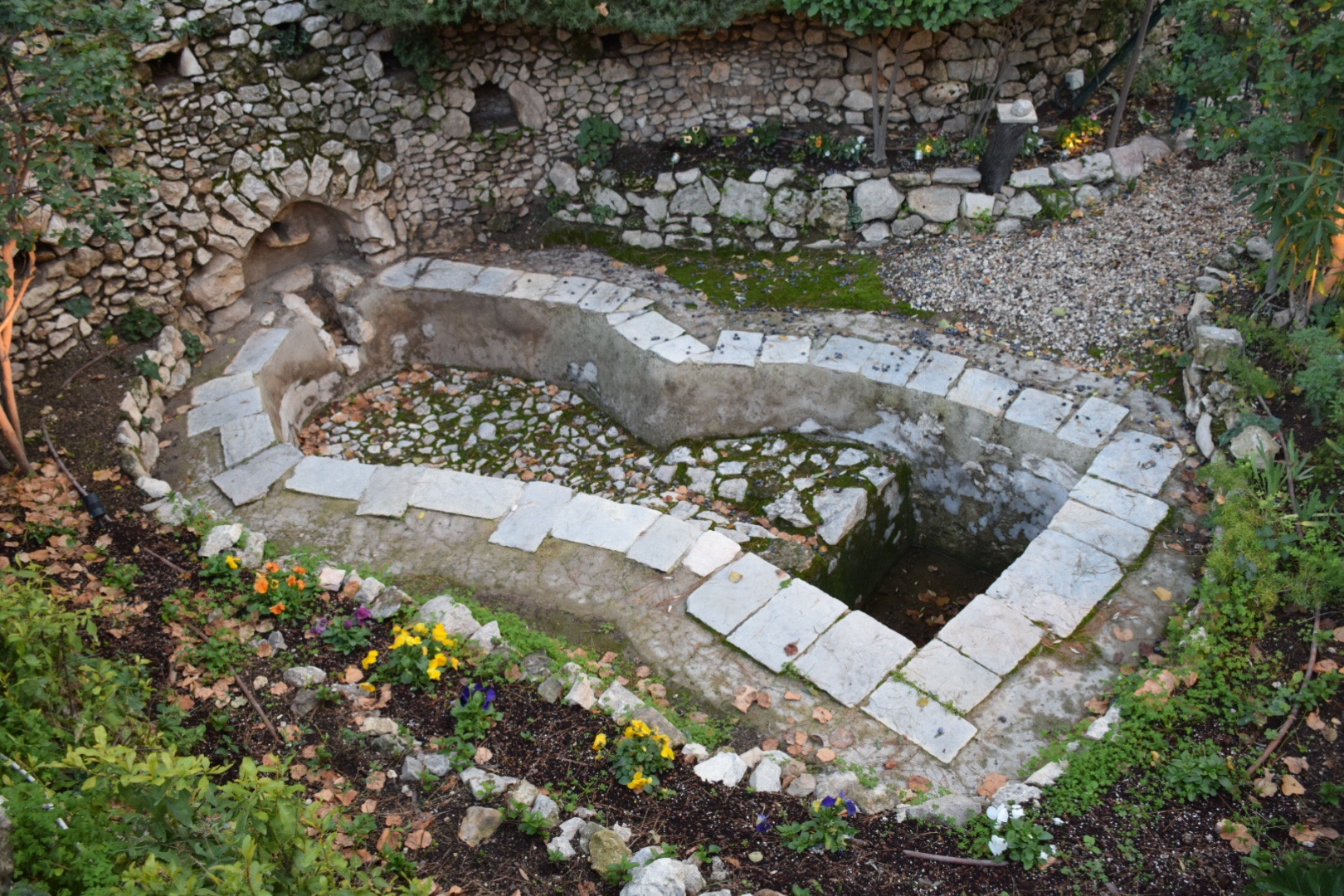
Right beside the tomb was discovered a wine press that were able to see on our way.
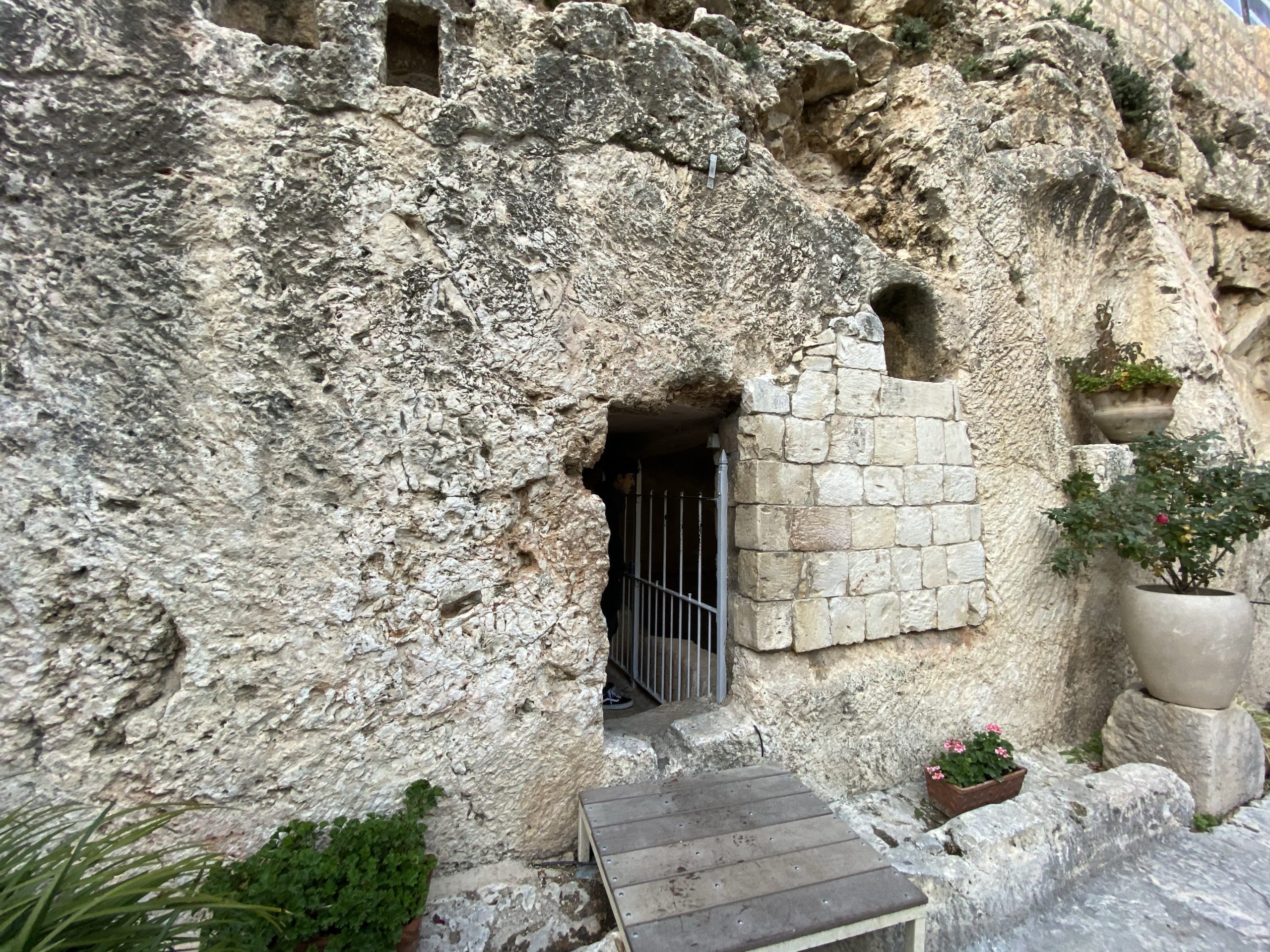
I really appreciated the phrase that Jenny used about this being a “visual aid,” because seeing it does help me understand the biblical narrative in a way that I had not before.
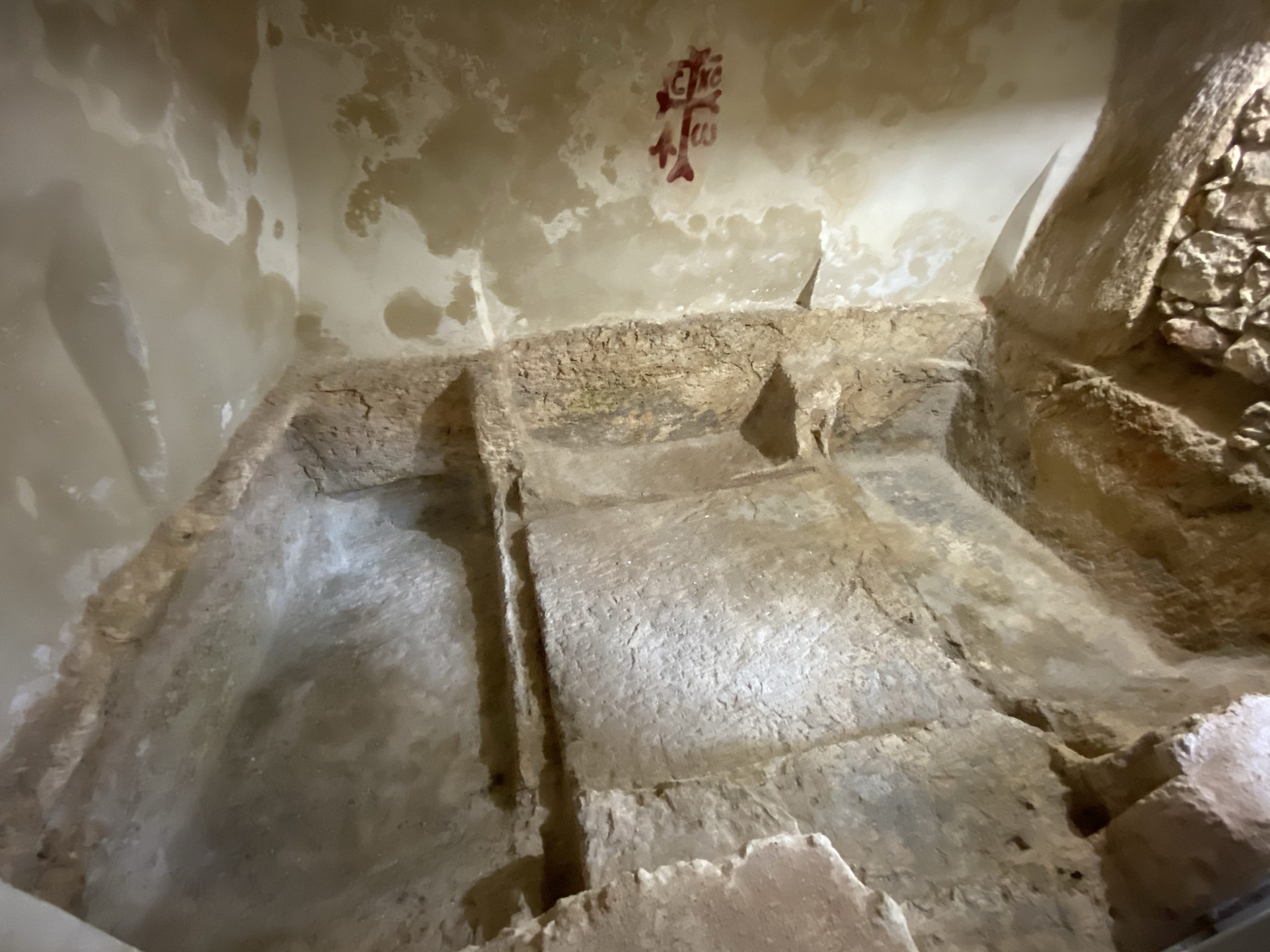
We each were able to enter and see the inside of the tomb. The track for the stone that would have been covering the door was clearly visible in the front. Jenny noted that the stone was not found but they had a small one next to the tomb as an example.
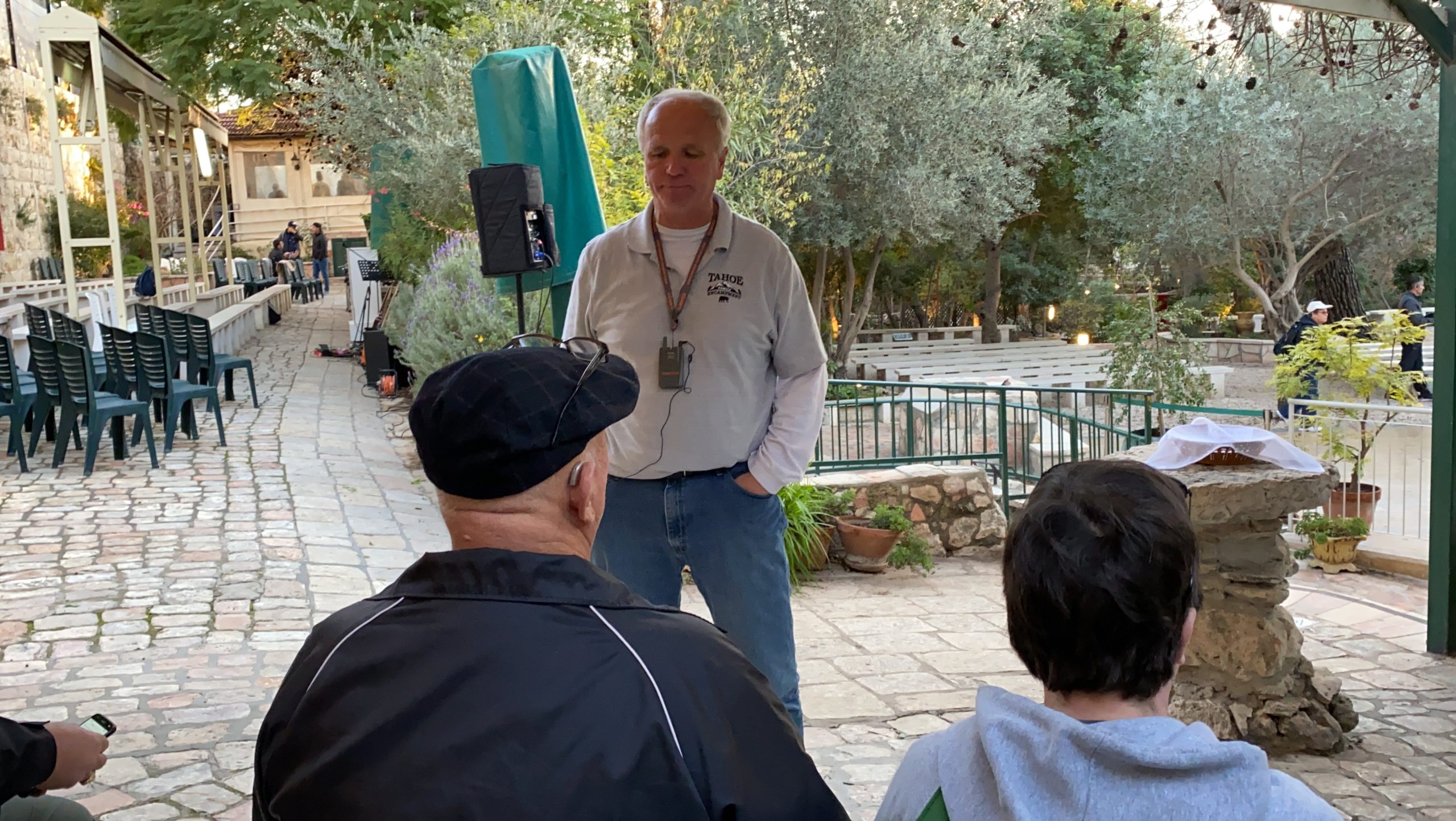
After touring the tomb, our group gathered, and Keith recited from the biblical account of his burial and resurrection. Jeff Hallums then led us in Low in the Grave He Lay.
From the garden tomb we walked back to meet the bus for our very short drive to the hotel. Murad told us that because we missed the Wailing Wall today, we would be leaving early tomorrow to see it before going to the City of David Museum.
We had a good dinner in the hotel and then a brief meeting with Dr. Cloud at 8pm. After the meeting I was able to talk to the girls back home for a while before turning in for the night.

I’ve been to Israel twice and how I wish I had such thorough and deep Biblical research as this! I am grateful to God that this interrupted me as if on its own, I remember the spots you describe as I wandered up the steep walkway at Mt of Olives. A local man told me how important Bethany was on the other side, offered to take me there, but I was a lone single woman off trail from my group, so, umm, no. What you have written is so dear to me, thank you!!! Shalom!!